First Look and Ride: 2016 Trek Madone 9-Series
Trek shoots for the moon with its new aero road bike
It was a Friday afternoon in late May and I was sitting in the atrium of Trek’s Waterloo, Wisconsin headquarters. I was there to get my first look at Trek’s new 2016 Madone and, during a small break in the action, catching up on some email. A meeting-room door opened to my left, and I watched over 100 men and women stream out. “Company meeting?” I asked my handler, Royce Breckon, Trek’s service brand manager. “Nope,” he said, “Engineering department meeting.”
As I would later learn, Trek has about 80 engineers worldwide; when support staff is counted, Trek’s engineering department employs about 200 individuals. While not all of them were involved in the creation of the new 2016 Madone 9-Series, this gives you an idea of the resources and horsepower that the company was able to put into its new aero road bike—and most ambitious model to date.
Trek has very high aspirations for the new Madone, calling its release, "the biggest launch in Trek’s history." Its tagline is “the ultimate race bike,” and to try and reach that benchmark, Trek considered aerodynamics, handling and rider comfort.
Related: Pro Cyclists Debut 2016 Trek Madone 9-Series
The frame is carbon composite, naturally, and the design is highly integrated in the pursuit of (claimed) class-leading aerodynamics. The new Madone also gets Trek’s IsoSpeed Decoupler—a seat tube decoupled from the top tube and seatstays so it may flex further and more easily, increasing vertical compliance—which was originally found on the Domane.
The 2016 Madone will be offered in two variations. One uses Trek’s highest grade 700 series carbon and the company’s H1 long-and-low fit, and is made in Waterloo, Wisconsin. The second is made of 600 series carbon and uses Trek’s H2 fit–taller stack and shorter reach compared to the same size in H1–and is made overseas.
The difference, besides fit: The H1 bike is a 100 grams lighter, and in Trek’s testing appears a bit stiffer and a bit more vertically compliant; however, on the open road, the two ride very similarly, says Michael Mayer, Trek’s global road brand manager. Both are considered the company’s top of the line 9-Series frames, but Trek says the customer who wants the H1 fit is more race-oriented and desires every bit of weight savings. A women’s version will be offered; however, it uses the same geometry as the standard H2 with some spec adjustment.
Trek claims a 56cm H1 Madone frame weighs 950 grams, and that a complete 56cm H1 bike with Dura-Ace Di2 and Bontrager Aeolus 3 wheels weighs just over 15 pounds.
Aerodynamics and Integration Using an iterative process, Trek took a computer model of the first aerodynamic Madone, launched in 2013, and modified, then tested; then modified some more and tested again. Hundreds of virtual models were created, each one trying to make the Madone a bit more slippery, but always with an eye on the bike’s other performance goals. Bottle placement alone was subject to 140 iterations before arriving at the most aerodynamic position, and Trek claims the Madone is more aerodynamic with bottles than without.
Shadows of the old Madone exist. Geometry is slightly tweaked, and the new Madone’s primary tube shapes are evolutions of the KVF (Kamm Virtual Foil) truncated airfoils introduced in the previous generation. But the new Madone has a much deeper downtube, and aerodynamically shaped seat tube and seatstays where the old used round tubes.
Trek tested the new Madone against the Cervelo S5, Giant Propel, and a Felt AR in the San Diego Wind Tunnel, which Trek considers to be the best and most accurate. Ben Coates, Trek’s road product manager, stressed that the company was pursuing real-world aerodynamics, so all the bikes in the wind tunnel comparison were equipped with two water bottles.
Though the Madone was not fastest at all yaw angles (the S5 and AR eclipsed it at some), Trek’s white paper on the new Madone claims the 2016 Madone is the “overall fastest bike across all yaw angles.” Trek also tested a first-generation Specialized Venge , but didn’t include it in their comparison, “based on data collected from previous test that showed it was not a leader in aerodynamics.” How the new Madone compares to the new Venge is unknown.
Trek’s evaluation then stepped outside the virtual world and the controlled environment of the wind tunnel, and into a velodrome and out on open roads. The claimed results: At 40kph, the new Madone provides a 19-watt savings over a non-aero race bike (Trek used their Emonda as a representative) in a solo time trial situation, and a 14-watt savings when drafting.
To realize these aerodynamic gains, Trek considered more than just the frame, designing dedicated brakes and an integrated bar and stem. The integrated bar and stem saves 34 grams of drag compared to a Bontrager XXX Aero bar, says Trek. The tops are intended to be ridden naked; wrapping them with tape wrecks the bar’s aerodynamics.

More drag savings, up to 37 grams, were realized by hiding the cables. They are run internally through the bar, exiting the stem just in front of the steerer clamp and immediately entering the frame. Except for the rear derailleur loop (or wire) and a tiny bit of rear brake cable, the new Madone has no exposed cables, housing, or wires.
Though the fork’s steerer tube where the stem attaches is effectively 1-1/8” diameter, it is relieved so the cables can enter the frame directly from the integrated bar. While it is possible to clamp other stems to the steerer, it is presently not possible to route the cables properly with anything else, nor use any headset spacers other than those that come with the frame. Speed and integration has its compromises.
For safety, Trek typically recommends that a fork steerer be cut so a few millimeters are exposed above the stem clamp. Doing so requires an extra headset spacer above the stem. The Madone’s stem, however, is designed with the extra spacer built in so the preload cap sits flat for less drag. Trek’s Blendr system accommodates the mounting of computers and lights to the bar.
Trek will offer 13 different versions of the integrated bar; all use the same Bontrager VR-CF variable radius drop, however, you will see some Trek Factory Racing riders with a team-only ergo-bend version. Bar widths are 40,42, and 44, all in 90-120mm lengths, as well as a 42x130.
The center pull brakes are unique to the Madone; no other brake is currently compatible with the frame. The brakes are “designed to seamlessly match the fork and seat stay surfaces, integrating with the recessed areas and allowing air to flow smoothly over the entire surface,” according to the Madone’s white paper. Though the mounting format looks similar to the Shimano direct mount standard—used by the previous Madone and Emonda—it is different enough that only Trek’s brake will work properly.
The dual-pivot brake matches the power of Shimano's excellent 9000-series brake caliper, says Trek, and leverage is adjustable for proper feel and performance with all the major component-maker’s brake levers. Wide rims are no problem, says Coates. Independently adjustable arm position allows the brake to, “work with every rim on the market today.”
After taking a trip down under the bottom bracket on the previous generation, the rear brake returns to the seatstays on the new Madone. Trek says this placement is a bit less aerodynamic, but easier to access and adjust, and, because of the way a wheel flexes, reduces brake rub. Almost all the hardware on both brakes is uncovered and easily accessible, and there is a lever to open the arms for wheel changes. You can’t compensate for brake pad wear by adjusting on the fly with a knob at the housing stop like you can on a typical side pull caliper. Instead, the arms must be moved closer to the rim with a hex wrench.
One of the more curious details of the new Madone are the “vector wings”. Government regulations state that a bike’s front wheel must be able to turn up to 65 degrees from center, even though a rider would almost never turn the bars that far when riding. However, the shape that Trek desired for the head tube, with internal cable routing for the front brake, did not allow this much rotation. The solution was a cover with sprung wings that accommodate this amount of steering. When the bar is turned far enough, the wing is pushed open by the brake; when the bar is turned back, the wing snaps closed.
“Ma-domane” Historically, one of the biggest complaints about aero bikes is an unrefined ride feel. Trek’s solution: Borrow the IsoSpeed Decoupler from the Domane. But Trek ran into a problem in applying it to the new bike: The aerodynamically shaped seat tube (the Domane’s seat tube is round) could not flex enough to provide worthwhile vertical compliance. The solution was to give the Madone a second, internal seat tube.
While the exterior “seat” tube is a structural part of the frame, the seat post is attached to second tube hidden inside the exterior tube. That way, the exposed part of this system is aero shaped, but it transitions to a round, bowed tube inside the frame. Anchored at the bottom bracket shell on one end and with the IsoSpeed decoupler at the top, the interior seat tube can then bend under load, providing about 20mm of vertical compliance; double that of its nearest competitor, claims Trek. Overall, Trek says the 2016 Madone has the same amount of vertical compliance as the Emonda, however, the Domane is about 50 percent more complaint than both.
Trek will offer two seat mast lengths, and two offsets, 5- and 25mm. The saddle clamp is all new, and provides independent adjustment of tilt and fore/aft position.
More Than Just Numbers Echoing a theme we’re hearing more often from more companies, Trek looked beyond just the on-paper numbers when refining the Madone’s feel and handling. The Madone’s white paper, available at Trek’s website, goes into detail on the topic, but here’s a summary based on my conversations with the people involved in the Madone’s development.
To collect real world data about the loads on a bike in typical riding situations, Trek builds aluminum test models and equips them with strain gauges to measure deflection, power meters, and speed and cadence sensors. Test riders subject the bikes to routine events: climbing, sprinting, and cornering, etc., while data recorders collected information from the sensors about the bike’s behavior in response to the events. Trek used this real world data to evaluate computer models, and to be sure the simulations they run on the frames provides an accurate picture of the way a bike would behave in the real world.
Using this method, Trek’s engineers could build several versions of a frame, each having different characteristics. Test riders then provided feedback about each frame’s desirable and undesirable traits. Essentially, the models gave Trek the tools to identify and tune the nuances that add up to what riders call “feel.”
In designing the new Madone, Trek took feedback from its pro factory racing team riders who said they really liked the way the Emonda rode. Thanks to its testing process, engineers had a good idea of what contributed to these positive characteristics, and they built much of that into the new Madone, even though the latter’s tube shapes are much different.
Then, in January 2014, Trek had its factory team riders evaluate three prototypes of the new Madone, each with a different carbon layup. That feedback was taken and used to further develop the new bike. A year later Trek had “full production” versions, again in three different layups, tested by the team again and used the feedback to lock in the final layup of the production 2016 Madone.
At the bike launches I attend, there is almost invariably some slide or discussion about drivetrain, head tube and torsional stiffness and how much awesome-r it is than the previous generation frame and/or competitor’s frames. But Trek’s people didn’t talk much about the Madone’s stiffness at the launch. My impression: They weren’t specifically gunning to achieve a benchmark in a certain test, or notable gains over the previous Madone, or exceed that of competitor’s frames. Their primary concern, I felt, was achieving the ride and handling goals that fulfilled the bike’s purpose, and they seemed quite confident that those goals were met. The resulting stiffness, measured in the traditional ways, is what it is—or so it would seem. They did let on that the Madone is, “a bit stiffer than an Emonda, and less stiff than a Domane.”
The Rest Aerodynamics, IsoSpeed and feel are the three points Trek is emphasizing with the new Madone, but there are other notable details as well.
The frame can accept up to 28mm wide tires. Yes. An aero frame with rim brakes that takes 28mm tires.
The Control Center is flat-out nifty. Found high up the down tube where it is accessible on the fly, it houses an electronic shifting system’s junction box (with Shimano, the junction box button for adjusting trim and to fine-tune shifting is accessible) or, for mechanical, contains a front derailleur cable-tension adjuster. When it’s time to charge the Di2, the charging port is accessed by releasing a catch, popping open the Control Center. Note: The frame is compatible with Campagnolo EPS drivetrains, but the battery must be mounted on the outside of the frame.
Carried over from Trek’s other models is its chain retention device (though the Madone’s is “more aerodynamic,” of course), DuoTrap speed and cadence sensor pocket, and BB92 bottom bracket.
Trek also incorporated a few Easter Eggs into the Madone’s paint. I don’t want to spoil the surprise so I’ll leave them to you to find.
Four complete bikes are offered, three with H2 geometry. All use the same brake calipers and integrated bar. Sizing now mirrors the Emonda. Seven sizes, 50-62cm, are offered in H1; and nine from 47 to 64cm in H2. - Madone 9.2, $6300, built with Shimano Ultegra 11 mechanical and Bontrager Paradigm aluminum wheels; - Madone 9.5 $8400, built with Shimano Dura-Ace 11 mechanical and Bontrager Aura 5 carbon wheels (aluminum brake track); - Madone 9.9 $12,600 built with Shimano Dura Ace Di2 11 and Bontrager Aeolus 5 carbon wheels. Also offered in a women’s version.
Also offered is the Madone Race Shop Limited $13,650, a replica of the bike the Trek Factory Racing team rides, with H1 geometry, Shimano Dura Ace Di2 and Bontrager Aeolus 5 carbon wheels.
The Madone in H1 and H2 fits are also offered through Trek’s Project One paint and parts customization program starting in August. The amazing, hot-pink abomination you see in the photos (note that Trek painted it in the colors I requested) was a H2 Project One dreamed up by yours truly.
Also offered is a frame module–brakes, one-piece bar and stem, and seat mast included–for $5,780 for the H1 and $4,730 for the H2.
How it Rides The new Madone H2 Project One came to the office for a couple of our most experienced testers to spend about a week each on the bike. Off the bat, we were impressed by the bike’s ride quality. One tester compared the bike to the Domane Classic, calling the ride “silky and smooth”; another said there was “good, aggressive-type, road and surface feedback with surprising smoothness—there were no instances of rough chatter over the odd bump.” They also noted that the bike felt very connected to the road, and that even when road conditions deteriorated, the tires tracked and stuck to the ground. The IsoSpeed decoupler gave the feeling of occasionally bottoming out—letting us know that it was indeed working. There was also no brake rub under sprinting, climbing, or pedal mashing.
The new Madone is also surprisingly comfortable: “I could be happy riding it all day, or for an hour crit,” was the comment. The bike handled precisely, and was easy to control over the road.
And of course, it felt fast. On one race-like weekly group ride, a tester observed that he seemed to be able to pedal less than others in the group, all else being equal, and that on a shallow downhill where he normally coasted at a steady speed, he felt like he was actually accelerating.
Overall, the impression came back that the Madone didn’t feel like an aero bike in the ways we typically expect: The ride wasn’t harsh and chattery, the bike was stiff, and while it didn’t feel feathery, it wasn’t heavy, either. As one tester put, “This just felt like a really nice road/racing bike.” And as another said, “It’s just an easy bike to like.”
The Ultimate? Is the 2016 Madone “the ultimate race bike”? Time may tell, but frankly, statements like these are usually unverifiable. Here’s what I know so far: It’s awesome to see Trek finding a bit of swagger and flexing its muscles. I can’t imagine the Trek of just a few years ago going for it they way the company did with the new Madone. This is an impressive bike. And, based on testers’ feedback, it is a great-riding bike. The Bicycling staff races, and loves racing, but we all ride more than we race. And when we ride, we love to go fast on great equipment. The 2016 Madone lets us do both. And it didn’t come cheap or easy—it took a lot of engineering manpower.


.css-1t6om3g:before{width:1.75rem;height:1.75rem;margin:0 0.625rem -0.125rem 0;content:'';display:inline-block;-webkit-background-size:1.25rem;background-size:1.25rem;background-color:#F8D811;color:#000;background-repeat:no-repeat;-webkit-background-position:center;background-position:center;}.loaded .css-1t6om3g:before{background-image:url(/_assets/design-tokens/bicycling/static/images/chevron-design-element.c42d609.svg);} Bike Reviews

The Best Beach Cruisers for Leisurely Rides

The Best Hardtail Mountain Bikes

Best Hybrid Bikes You Can Buy Right Now

The 14 Best Road Bikes of 2024

The Best Commuter Bikes for Getting Around Town
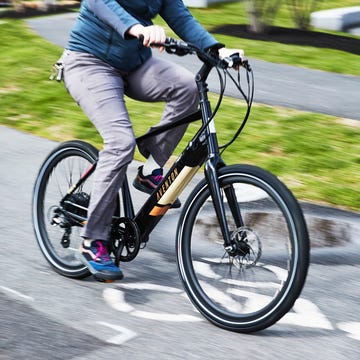
The 10 Best Electric Bikes, Tested by Our Editors
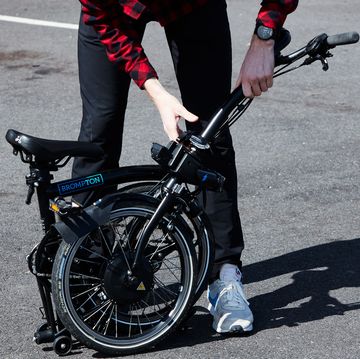
These Folding Bikes Can Go Everywhere

Smoother and Faster: The New Pivot Switchblade

The Best Beginner Mountain Bikes

Reviewed: Colnago's Italian Made C68 Gravel
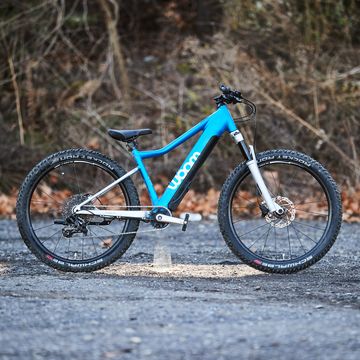
The 6 Best Kids’ Bikes in 2024
2-FOR-1 GA TICKETS WITH OUTSIDE+
Don’t miss Thundercat, Fleet Foxes, and more at the Outside Festival.
GET TICKETS
BEST WEEK EVER
Try out unlimited access with 7 days of Outside+ for free.
Start Your Free Trial
Powered by Outside
First-look review: 2016 Trek Madone
Heading out the door? Read this article on the new Outside+ app available now on iOS devices for members! >","name":"in-content-cta","type":"link"}}'>Download the app .
In the build-up to this year’s Tour de France we see yet another bike launch from one of the big players of the industry. This time it’s Trek with the launch of the company’s 2016 edition, 9 Series Madone. CyclingTips’ Dave Everett was in The Netherlands for the launch and wrote this about his first impressions of the bike.
In an upmarket hotel theatre in Zeist, The Netherlands, Trek president John Burke took centre stage at a glitzy presentation as he showcased the 2016 Trek Madone. His first words made it clear what Trek feel they have created: “the ultimate race bike”.
The bike in question has had a few spy shots of it snapped over the past month after Bauke Mollema was spotted racing it at the Criterium du Dauphine.

In the flesh, the bike looks to be a big leap forward when compared to the older Madone model, thanks to deeper tubing and a whole raft of new features.
It’s a bike that’s been in development for more than one and a half years with input from Trek’s professional road team. Trek says that it’s been through more than 100 different versions to arrive at what will be hitting stores in August.
On hand to help with the presentation was Trek Factory Racing’s “Ambassador of Awesome”, Jens Voigt. He, along with early test pilot Bauke Molloma, had a hand in the development. In Voigt’s own words: “I feel like I’ve retired too early. I need to make a comeback — the bike is really sexy”.
Much like the recently released Specialized Venge ViAS , Trek claims the new Madone is the fastest bike on the market. But this isn’t the only thing Trek is using to market its new bike — component integration and the ride quality are other factors that guided the design and development of the bike.
The new Madone carries over Trek’s KVF tubing from the previous model, a kammtail tubing design that in essence sees the tail edge of a teardrop-shaped tube sliced off. This creates a much ‘boxier’ shape while facilitating the same aero advantages as the teardrop shape. The new Madone sees this design taken further than the previous model with deeper tubing in several places.

The deeper tubing is only one part that helps to reduce drag. Bottle cage placement, like on the new Cannonade Evo Hi-Mod, is something that Trek has addressed. According to Trek, over 140 iterations were carried out on bottle cage placement before they settled on the final position; a position that provides a claimed 5.5% reduction in the drag (of that section of the bike). This optimisation process was done with the use of a software package called HEEDS.
However, computer simulations and wind tunnel testing are only part of Trek’s testing protocol.
Back in January we visited Trek while they were testing three of their riders’ time trial positions for the upcoming Paris-Nice ITT. At that time they were using an analysis program called Alphamantis. Several days after our visit the team attended the Palma track again and tested a prototype version of the Madone using Alphamantis. On the track and using the software, Trek found that the bike provided a claimed 19-watt advantage over a standard road bike (the Emonda) at 40km/h.
Real-world testing of the new bike was also undertaken, but more on that in a moment.
For me, the most impressive thing about the new Madone is the way Trek has seemingly managed to produce a more compliant and comfortable ride while still maintaining the aero tubing shape.
With large, deep, boxy-shaped tubes comes the problem of a harsh and unforgiving ride. Trek claims that they have eliminated this problem through the use of their IsoSpeed system. We’ve seen this before on Trek’s Domane road bike and it’s also available on Trek’s top-end hardtail mountain bike, the Procaliber. The 2016 Madone takes the IsoSpeed design in a slightly different direction with an impressive tube-in-tube design.

Trek came to the conclusion that they needed to separate the aero properties of the bike from the comfort. To do this, the outer body tubing of the frame takes the load from the bottom bracket and takes care of the aero properties of the frame. Inside this tube sits a more rounded and more compliant tube that reportedly flexes to reduce what would otherwise be, as Trek admits, “a harsh ride”.
We here at CyclingTips can’t say if the IsoSpeed solution works as claimed as we haven’t yet had an opportunity to ride the bike. But we will have a long-term test coming up soon.
The Trek white paper on the new Madone states that: “The internal tube of the IsoSpeed system deflects and maintains the excellent vertical compliance Madone is known for. The result: an incredible 57.5% improvement in vertical compliance over the nearest competitor.”
According to Trek, this “nearest competitor” was the Giant Propel .
How does Trek measure this compliance?
“Trek have a bike with a mesh-like strain gauge system, power meter and accelerometers covering it,” Trek’s global road product manager Ben Coates told me. “This is used in a real-world environment by our professional test riders [to give us a detailed feed of information on how the frame is performing.”
Integration
Component integration is something we’ve seen with several new bikes recently and Trek adds to this growing trend with several features that make the bike look sleek even when it’s standing still. The one huge talking-point at the launch was that of the Vector Wings.

These fairings hide the upper part and the cables of the front brake. Hinged doors placed on either side of the base of the headtube swing open on springs when the forks are turned, forced opened by the upper part of the brake. It’s a neat design feature that catches the eye and solves the problem of having cables exposed to the wind.
When asked how they managed to get the design to meet the UCI’s stringent rules on fairings, Ben Coates said: “It’s not actually a fairing — it’s a covering; a rain protector”. Hats off to Trek’s marketing arm for managing this coup as many would class the Vector Wings as a fairing of sorts.
The Vector Wings are just a small part of an overall integrated system. One component that a few brands seem to dismiss when designing a new bike is the junction box for Shimano’s Di2 or Campagnolo’s EPS electronic groupset. Specialized have tackled this problem by placing the box under the bottom bracket while Trek have placed it in the downtube just behind the headtube in what they dub “the control centre”.
Here it is accessible and held in place via a removable cover that houses the junction box as well as the battery. Removing this cover via a small tab allows you to access the battery for charging. When the cover is closed you still have access to the usual buttons on the junction box.
When running a mechanical groupset the control centre has a barrel adjuster for the front derailleur.

I asked Ben Coates whether disc brakes had been an option for the new Madone at any stage of development. He told me: “Disc brakes as of now aren’t ideal for an aero bike. They have their place, but the trade-offs aren’t ideal for this bike.
“The performance is better with discs without a doubt, but the extra weight and reduced aero performance aren’t worth that trade off yet. That’s not to say that that won’t change in the future though”
The brakes on the new Madone are yet another talking point. Direct-mount centre-pull brakes have been designed in conjunction with the frame. The design allows all the usual adjustments you’d find with a calliper brake, via several screws. The brake arms use independent spring tension adjustment screws to centre the brake pads and adjust the lever pull force to the desired feel. Additionally, the two spacing screws allow precise pad adjustments.

The spacing screws’ range allows up to 6mm of difference when and if you swap between rims widths without having to adjusting the centre wedge.
The rear brake cable comes out from the rear of the seattube having run down the toptube from the bars. It’s a direct line that, due to different frame sizes, required a couple of different solutions. With the smaller frame sizes (52cm and below) the seatstay has a cut out to allow the brakes to sit in a position that allows the cable to have the same routing.
Trek claims that this bar and stem setup, with its internal cables, saves 34 grams of drag (0-20 degrees yaw average) when compared to the current Bontrager XXX Aero bar. The cables are tucked away inside the bars and a channel along the front edge of the fork allows access to the front brake cable.
Hiding the cables in this fashion has a claimed 40 grams of drag saving.

Mechanics may dread these hitting the stores as I’m guessing there’ll be a learning curve involved in trying to route the cables. One feature that eliminates the problem of having to reroute the cables if you need to adjust the stack hight of your stem is the inclusion of split cam-like spacers.
The spacers come in two halves and clip together. When extending or lowering the bar/stem you simply undo the stem and slip the two parts in or out of place. It’s a feature that I’m sure many will appreciate.

The 2016 Trek Madone is being offered in three different sizings: the race-orientated H1, the taller-headtubed H2, and a women’s-specific Madone. Five models will be available:
- The Race Shop Limited edition, a carbon copy of what the team uses and that retails at AUD $15,999
- The 9.9 and 9.9 women’s version (both $13,999), which are kitted out with Di2 shifters and mechs plus Aeolus 5 wheels
- The 9.5 ($7,999), which comes fully loaded with mechanical Dura-Ace and Bontrager’s Paradigm RXL wheels
- The base model 9.2 ($6,400), equipped with mechanical Ultegra and Bontrager’s Paradigm Elite tubeless wheels
Each of the H2 versions come with compact cranks. All will be available in seven frame sizes, from 50cm through to 62cm in 2cm increments. The women’s version is only available in four sizes, 50 through to 56.
Finishing kit level varies depending on each model, but all come from Trek’s in-house brand Bontrager.
The design and development of the new Madone is something that Trek clearly feels proud of. Indeed, John Burke announced that the launch was “the biggest day in Trek’s history”. We’re looking forward to test riding the new bike and seeing if it lives up to the promises Trek has made.
Popular on Velo
\n >\", \"path\": \"https:\/\/velo.outsideonline.com\/news\/rapha-north-america-abruptly-closes-bentonville-office-lays-off-staff\/\", \"listing_type\": \"recirc\", \"location\": \"list\", \"title\": \"rapha north america abruptly closes bentonville office, lays off staff\"}}\u0027>\n rapha north america abruptly closes bentonville office, lays off staff\n \n \n \n \n \n\n \n \n \n \n \n\n \n "},{"title":"the ritchey montebello brings steel goodness to all-road","url":"https:\/\/velo.outsideonline.com\/road\/road-gear\/ritchey-montebello-brings-steel-goodness-to-all-road\/","markup":" \n \n\n\n \n\n \n \n >\", \"path\": \"https:\/\/velo.outsideonline.com\/road\/road-gear\/ritchey-montebello-brings-steel-goodness-to-all-road\/\", \"listing_type\": \"recirc\", \"location\": \"list\", \"title\": \"the ritchey montebello brings steel goodness to all-road\"}}\u0027>\n \n \n \n \n \n \n\n \n \n\n \n\n \n \n\n \n \n >\", \"path\": \"https:\/\/velo.outsideonline.com\/road\/road-gear\/ritchey-montebello-brings-steel-goodness-to-all-road\/\", \"listing_type\": \"recirc\", \"location\": \"list\", \"title\": \"the ritchey montebello brings steel goodness to all-road\"}}\u0027>\n the ritchey montebello brings steel goodness to all-road\n \n \n \n \n \n\n \n \n \n \n \n\n \n "},{"title":"over 114,000 acres of maine wilderness are now open to gravel biking","url":"https:\/\/velo.outsideonline.com\/gravel\/maine-promotes-gravel-cycling\/","markup":" \n \n\n\n \n\n \n \n >\", \"path\": \"https:\/\/velo.outsideonline.com\/gravel\/maine-promotes-gravel-cycling\/\", \"listing_type\": \"recirc\", \"location\": \"list\", \"title\": \"over 114,000 acres of maine wilderness are now open to gravel biking\"}}\u0027>\n \n \n \n \n \n \n\n \n \n\n \n\n \n \n\n \n \n >\", \"path\": \"https:\/\/velo.outsideonline.com\/gravel\/maine-promotes-gravel-cycling\/\", \"listing_type\": \"recirc\", \"location\": \"list\", \"title\": \"over 114,000 acres of maine wilderness are now open to gravel biking\"}}\u0027>\n over 114,000 acres of maine wilderness are now open to gravel biking\n \n \n \n \n \n\n \n \n \n \n \n\n \n "},{"title":"8 new shoes from giro, q36.5, shimano, fizik, lake, and crankbrothers","url":"https:\/\/velo.outsideonline.com\/road\/road-gear\/8-new-shoes-from-giro-q36-5-shimano-fizik-lake-and-crankbrothers\/","markup":" \n \n\n\n \n\n \n \n >\", \"path\": \"https:\/\/velo.outsideonline.com\/road\/road-gear\/8-new-shoes-from-giro-q36-5-shimano-fizik-lake-and-crankbrothers\/\", \"listing_type\": \"recirc\", \"location\": \"list\", \"title\": \"8 new shoes from giro, q36.5, shimano, fizik, lake, and crankbrothers\"}}\u0027>\n \n \n \n \n \n \n\n \n \n\n \n\n \n \n\n \n \n >\", \"path\": \"https:\/\/velo.outsideonline.com\/road\/road-gear\/8-new-shoes-from-giro-q36-5-shimano-fizik-lake-and-crankbrothers\/\", \"listing_type\": \"recirc\", \"location\": \"list\", \"title\": \"8 new shoes from giro, q36.5, shimano, fizik, lake, and crankbrothers\"}}\u0027>\n 8 new shoes from giro, q36.5, shimano, fizik, lake, and crankbrothers\n \n \n \n \n \n\n \n \n \n \n \n\n \n "},{"title":"tom pidcock leaves li\u00e8ge in frustration: \u2018i was setting all-time power numbers\u2019","url":"https:\/\/velo.outsideonline.com\/road\/road-racing\/tom-pidcock-leaves-liege-in-frustration-i-was-setting-all-time-power-numbers\/","markup":" \n \n\n\n \n\n \n \n >\", \"path\": \"https:\/\/velo.outsideonline.com\/road\/road-racing\/tom-pidcock-leaves-liege-in-frustration-i-was-setting-all-time-power-numbers\/\", \"listing_type\": \"recirc\", \"location\": \"list\", \"title\": \"tom pidcock leaves li\u00e8ge in frustration: \u2018i was setting all-time power numbers\u2019\"}}\u0027>\n \n \n \n \n \n \n\n \n \n\n \n\n \n \n\n \n \n >\", \"path\": \"https:\/\/velo.outsideonline.com\/road\/road-racing\/tom-pidcock-leaves-liege-in-frustration-i-was-setting-all-time-power-numbers\/\", \"listing_type\": \"recirc\", \"location\": \"list\", \"title\": \"tom pidcock leaves li\u00e8ge in frustration: \u2018i was setting all-time power numbers\u2019\"}}\u0027>\n tom pidcock leaves li\u00e8ge in frustration: \u2018i was setting all-time power numbers\u2019\n \n \n \n \n \n\n \n \n \n \n \n\n \n "},{"title":"tadej poga\u010dar seizes li\u00e8ge-bastogne-li\u00e8ge with dominant solo display","url":"https:\/\/velo.outsideonline.com\/road\/road-racing\/tadej-pogacar-seizes-liege-bastogne-liege-with-dominant-solo-display\/","markup":" \n \n\n\n \n\n \n \n >\", \"path\": \"https:\/\/velo.outsideonline.com\/road\/road-racing\/tadej-pogacar-seizes-liege-bastogne-liege-with-dominant-solo-display\/\", \"listing_type\": \"recirc\", \"location\": \"list\", \"title\": \"tadej poga\u010dar seizes li\u00e8ge-bastogne-li\u00e8ge with dominant solo display\"}}\u0027>\n \n \n \n \n \n \n\n \n \n\n \n\n \n \n\n \n \n >\", \"path\": \"https:\/\/velo.outsideonline.com\/road\/road-racing\/tadej-pogacar-seizes-liege-bastogne-liege-with-dominant-solo-display\/\", \"listing_type\": \"recirc\", \"location\": \"list\", \"title\": \"tadej poga\u010dar seizes li\u00e8ge-bastogne-li\u00e8ge with dominant solo display\"}}\u0027>\n tadej poga\u010dar seizes li\u00e8ge-bastogne-li\u00e8ge with dominant solo display\n \n \n \n \n \n\n \n \n \n \n \n\n \n "},{"title":"7 new bikes we found at sea otter","url":"https:\/\/velo.outsideonline.com\/road\/road-gear\/7-new-bikes-we-found-at-sea-otter\/","markup":" \n \n\n\n \n\n \n \n >\", \"path\": \"https:\/\/velo.outsideonline.com\/road\/road-gear\/7-new-bikes-we-found-at-sea-otter\/\", \"listing_type\": \"recirc\", \"location\": \"list\", \"title\": \"7 new bikes we found at sea otter\"}}\u0027>\n \n \n \n \n \n \n\n \n \n\n \n\n \n \n\n \n \n >\", \"path\": \"https:\/\/velo.outsideonline.com\/road\/road-gear\/7-new-bikes-we-found-at-sea-otter\/\", \"listing_type\": \"recirc\", \"location\": \"list\", \"title\": \"7 new bikes we found at sea otter\"}}\u0027>\n 7 new bikes we found at sea otter\n \n \n \n \n \n\n \n \n \n \n \n\n \n "},{"title":"sea otter randoms: the one about carrying cargo of all kinds","url":"https:\/\/velo.outsideonline.com\/urban\/urban-gear\/sea-otter-randoms-the-one-about-carrying-cargo-of-all-kinds\/","markup":" \n \n\n\n \n\n \n \n >\", \"path\": \"https:\/\/velo.outsideonline.com\/urban\/urban-gear\/sea-otter-randoms-the-one-about-carrying-cargo-of-all-kinds\/\", \"listing_type\": \"recirc\", \"location\": \"list\", \"title\": \"sea otter randoms: the one about carrying cargo of all kinds\"}}\u0027>\n \n \n \n \n \n \n\n \n \n\n \n\n \n \n\n \n \n >\", \"path\": \"https:\/\/velo.outsideonline.com\/urban\/urban-gear\/sea-otter-randoms-the-one-about-carrying-cargo-of-all-kinds\/\", \"listing_type\": \"recirc\", \"location\": \"list\", \"title\": \"sea otter randoms: the one about carrying cargo of all kinds\"}}\u0027>\n sea otter randoms: the one about carrying cargo of all kinds\n \n \n \n \n \n\n \n \n \n \n \n\n \n "},{"title":"gallery: 16 attention grabbing bikes from the sea otter classic","url":"https:\/\/velo.outsideonline.com\/road\/road-gear\/16-attention-grabbing-bikes-sea-otter-classic\/","markup":" \n \n\n\n \n\n \n \n >\", \"path\": \"https:\/\/velo.outsideonline.com\/road\/road-gear\/16-attention-grabbing-bikes-sea-otter-classic\/\", \"listing_type\": \"recirc\", \"location\": \"list\", \"title\": \"gallery: 16 attention grabbing bikes from the sea otter classic\"}}\u0027>\n \n \n \n \n \n \n\n \n \n\n \n\n \n \n\n \n \n >\", \"path\": \"https:\/\/velo.outsideonline.com\/road\/road-gear\/16-attention-grabbing-bikes-sea-otter-classic\/\", \"listing_type\": \"recirc\", \"location\": \"list\", \"title\": \"gallery: 16 attention grabbing bikes from the sea otter classic\"}}\u0027>\n gallery: 16 attention grabbing bikes from the sea otter classic\n \n \n \n \n \n\n \n \n \n \n \n\n \n "},{"title":"haro bikes is set to release a new race road bike and gravel bike. wait, what","url":"https:\/\/velo.outsideonline.com\/road\/road-gear\/haro-buzzard-rivette-road-gravel\/","markup":" \n \n\n\n \n\n \n \n >\", \"path\": \"https:\/\/velo.outsideonline.com\/road\/road-gear\/haro-buzzard-rivette-road-gravel\/\", \"listing_type\": \"recirc\", \"location\": \"list\", \"title\": \"haro bikes is set to release a new race road bike and gravel bike. wait, what\"}}\u0027>\n \n \n \n \n \n \n\n \n \n\n \n\n \n \n\n \n \n >\", \"path\": \"https:\/\/velo.outsideonline.com\/road\/road-gear\/haro-buzzard-rivette-road-gravel\/\", \"listing_type\": \"recirc\", \"location\": \"list\", \"title\": \"haro bikes is set to release a new race road bike and gravel bike. wait, what\"}}\u0027>\n haro bikes is set to release a new race road bike and gravel bike. wait, what\n \n \n \n \n \n\n \n \n \n \n \n\n \n "},{"title":"\u2018cycling sucks sometimes\u2019: what poga\u010dar, van der poel and pidcock said before li\u00e8ge-bastogne-li\u00e8ge","url":"https:\/\/velo.outsideonline.com\/road\/road-racing\/cycling-sucks-sometimes-what-pogacar-van-der-poel-and-pidcock-said-before-liege-bastogne-liege\/","markup":" \n \n\n\n \n\n \n \n >\", \"path\": \"https:\/\/velo.outsideonline.com\/road\/road-racing\/cycling-sucks-sometimes-what-pogacar-van-der-poel-and-pidcock-said-before-liege-bastogne-liege\/\", \"listing_type\": \"recirc\", \"location\": \"list\", \"title\": \"\u2018cycling sucks sometimes\u2019: what poga\u010dar, van der poel and pidcock said before li\u00e8ge-bastogne-li\u00e8ge\"}}\u0027>\n \n \n \n \n \n \n\n \n \n\n \n\n \n \n\n \n \n >\", \"path\": \"https:\/\/velo.outsideonline.com\/road\/road-racing\/cycling-sucks-sometimes-what-pogacar-van-der-poel-and-pidcock-said-before-liege-bastogne-liege\/\", \"listing_type\": \"recirc\", \"location\": \"list\", \"title\": \"\u2018cycling sucks sometimes\u2019: what poga\u010dar, van der poel and pidcock said before li\u00e8ge-bastogne-li\u00e8ge\"}}\u0027>\n \u2018cycling sucks sometimes\u2019: what poga\u010dar, van der poel and pidcock said before li\u00e8ge-bastogne-li\u00e8ge\n \n \n \n \n \n\n \n \n \n \n \n\n \n "},{"title":"sea otter randoms: riser handlebars, nifty racks, and tubes aren\u2019t dead","url":"https:\/\/velo.outsideonline.com\/news\/sea-otter-randoms-riser-handlebars-nifty-racks-and-tubes-arent-dead\/","markup":" \n \n\n\n \n\n \n \n >\", \"path\": \"https:\/\/velo.outsideonline.com\/news\/sea-otter-randoms-riser-handlebars-nifty-racks-and-tubes-arent-dead\/\", \"listing_type\": \"recirc\", \"location\": \"list\", \"title\": \"sea otter randoms: riser handlebars, nifty racks, and tubes aren\u2019t dead\"}}\u0027>\n \n \n \n \n \n \n\n \n \n\n \n\n \n \n\n \n \n >\", \"path\": \"https:\/\/velo.outsideonline.com\/news\/sea-otter-randoms-riser-handlebars-nifty-racks-and-tubes-arent-dead\/\", \"listing_type\": \"recirc\", \"location\": \"list\", \"title\": \"sea otter randoms: riser handlebars, nifty racks, and tubes aren\u2019t dead\"}}\u0027>\n sea otter randoms: riser handlebars, nifty racks, and tubes aren\u2019t dead\n \n \n \n \n \n\n \n \n \n \n \n\n \n "},{"title":"the thesis n1 wants to be your sole drop bar bike for everything","url":"https:\/\/velo.outsideonline.com\/gravel\/gravel-gear\/thesis-n1-do-everything-drop-bar-bike\/","markup":" \n \n\n\n \n\n \n \n >\", \"path\": \"https:\/\/velo.outsideonline.com\/gravel\/gravel-gear\/thesis-n1-do-everything-drop-bar-bike\/\", \"listing_type\": \"recirc\", \"location\": \"list\", \"title\": \"the thesis n1 wants to be your sole drop bar bike for everything\"}}\u0027>\n \n \n \n \n \n \n\n \n \n\n \n\n \n \n\n \n \n >\", \"path\": \"https:\/\/velo.outsideonline.com\/gravel\/gravel-gear\/thesis-n1-do-everything-drop-bar-bike\/\", \"listing_type\": \"recirc\", \"location\": \"list\", \"title\": \"the thesis n1 wants to be your sole drop bar bike for everything\"}}\u0027>\n the thesis n1 wants to be your sole drop bar bike for everything\n \n \n \n \n \n\n \n \n \n \n \n\n \n "},{"title":"xpedo\u2019s new power meter pedals are ready for the spotlight","url":"https:\/\/velo.outsideonline.com\/road\/road-gear\/xpedo-new-power-sonik-omni-and-thrust-omni-meter-pedals-sea-otter-classic\/","markup":" \n \n\n\n \n\n \n \n >\", \"path\": \"https:\/\/velo.outsideonline.com\/road\/road-gear\/xpedo-new-power-sonik-omni-and-thrust-omni-meter-pedals-sea-otter-classic\/\", \"listing_type\": \"recirc\", \"location\": \"list\", \"title\": \"xpedo\u2019s new power meter pedals are ready for the spotlight\"}}\u0027>\n \n \n \n \n \n \n\n \n \n\n \n\n \n \n\n \n \n >\", \"path\": \"https:\/\/velo.outsideonline.com\/road\/road-gear\/xpedo-new-power-sonik-omni-and-thrust-omni-meter-pedals-sea-otter-classic\/\", \"listing_type\": \"recirc\", \"location\": \"list\", \"title\": \"xpedo\u2019s new power meter pedals are ready for the spotlight\"}}\u0027>\n xpedo\u2019s new power meter pedals are ready for the spotlight\n \n \n \n \n \n\n \n \n \n \n \n\n \n "},{"title":"mathieu van der poel realistic about quest for monument sweep: \u2018even with roubaix legs i cannot follow poga\u010dar\u2019","url":"https:\/\/velo.outsideonline.com\/road\/road-racing\/mathieu-van-der-poel-realistic-about-quest-for-fourth-monument-even-with-roubaix-legs-i-cannot-follow-pogacar-here\/","markup":" \n \n\n\n \n\n \n \n >\", \"path\": \"https:\/\/velo.outsideonline.com\/road\/road-racing\/mathieu-van-der-poel-realistic-about-quest-for-fourth-monument-even-with-roubaix-legs-i-cannot-follow-pogacar-here\/\", \"listing_type\": \"recirc\", \"location\": \"list\", \"title\": \"mathieu van der poel realistic about quest for monument sweep: \u2018even with roubaix legs i cannot follow poga\u010dar\u2019\"}}\u0027>\n \n \n \n \n \n \n\n \n \n\n \n\n \n \n\n \n \n >\", \"path\": \"https:\/\/velo.outsideonline.com\/road\/road-racing\/mathieu-van-der-poel-realistic-about-quest-for-fourth-monument-even-with-roubaix-legs-i-cannot-follow-pogacar-here\/\", \"listing_type\": \"recirc\", \"location\": \"list\", \"title\": \"mathieu van der poel realistic about quest for monument sweep: \u2018even with roubaix legs i cannot follow poga\u010dar\u2019\"}}\u0027>\n mathieu van der poel realistic about quest for monument sweep: \u2018even with roubaix legs i cannot follow poga\u010dar\u2019\n \n \n \n \n \n\n \n \n \n \n \n\n \n "},{"title":"results: keegan swenson and sofia gomez villafa\u00f1e win the fuego xl at sea otter classic","url":"https:\/\/velo.outsideonline.com\/news\/fuego-xl-sea-otter-results\/","markup":" \n \n\n\n \n\n \n \n >\", \"path\": \"https:\/\/velo.outsideonline.com\/news\/fuego-xl-sea-otter-results\/\", \"listing_type\": \"recirc\", \"location\": \"list\", \"title\": \"results: keegan swenson and sofia gomez villafa\u00f1e win the fuego xl at sea otter classic\"}}\u0027>\n \n \n \n \n \n \n\n \n \n\n \n\n \n \n\n \n \n >\", \"path\": \"https:\/\/velo.outsideonline.com\/news\/fuego-xl-sea-otter-results\/\", \"listing_type\": \"recirc\", \"location\": \"list\", \"title\": \"results: keegan swenson and sofia gomez villafa\u00f1e win the fuego xl at sea otter classic\"}}\u0027>\n results: keegan swenson and sofia gomez villafa\u00f1e win the fuego xl at sea otter classic\n \n \n \n \n \n\n \n \n \n \n \n\n \n "},{"title":"ride the rockies canceled for 2024, future uncertain","url":"https:\/\/velo.outsideonline.com\/news\/ride-the-rockies-canceled-due-to-low-registration-future-uncertain\/","markup":" \n \n\n\n \n\n \n \n >\", \"path\": \"https:\/\/velo.outsideonline.com\/news\/ride-the-rockies-canceled-due-to-low-registration-future-uncertain\/\", \"listing_type\": \"recirc\", \"location\": \"list\", \"title\": \"ride the rockies canceled for 2024, future uncertain\"}}\u0027>\n \n \n \n \n \n \n\n \n \n\n \n\n \n \n\n \n \n >\", \"path\": \"https:\/\/velo.outsideonline.com\/news\/ride-the-rockies-canceled-due-to-low-registration-future-uncertain\/\", \"listing_type\": \"recirc\", \"location\": \"list\", \"title\": \"ride the rockies canceled for 2024, future uncertain\"}}\u0027>\n ride the rockies canceled for 2024, future uncertain\n \n \n \n \n \n\n \n \n \n \n \n\n \n "},{"title":"the cadex race integrated bar is as light as it is good looking","url":"https:\/\/velo.outsideonline.com\/road\/road-gear\/cadex-race-integrated-bar-first-look\/","markup":" \n \n\n\n \n\n \n \n >\", \"path\": \"https:\/\/velo.outsideonline.com\/road\/road-gear\/cadex-race-integrated-bar-first-look\/\", \"listing_type\": \"recirc\", \"location\": \"list\", \"title\": \"the cadex race integrated bar is as light as it is good looking\"}}\u0027>\n \n \n \n \n \n \n\n \n \n\n \n\n \n \n\n \n \n >\", \"path\": \"https:\/\/velo.outsideonline.com\/road\/road-gear\/cadex-race-integrated-bar-first-look\/\", \"listing_type\": \"recirc\", \"location\": \"list\", \"title\": \"the cadex race integrated bar is as light as it is good looking\"}}\u0027>\n the cadex race integrated bar is as light as it is good looking\n \n \n \n \n \n\n \n \n \n \n \n\n \n "},{"title":"time to plan your next trip: 5 companies with new bike bags at sea otter","url":"https:\/\/velo.outsideonline.com\/gravel\/gravel-gear\/new-bike-bags-at-this-years-sea-otter\/","markup":" \n \n\n\n \n\n \n \n >\", \"path\": \"https:\/\/velo.outsideonline.com\/gravel\/gravel-gear\/new-bike-bags-at-this-years-sea-otter\/\", \"listing_type\": \"recirc\", \"location\": \"list\", \"title\": \"time to plan your next trip: 5 companies with new bike bags at sea otter\"}}\u0027>\n \n \n \n \n \n \n\n \n \n\n \n\n \n \n\n \n \n >\", \"path\": \"https:\/\/velo.outsideonline.com\/gravel\/gravel-gear\/new-bike-bags-at-this-years-sea-otter\/\", \"listing_type\": \"recirc\", \"location\": \"list\", \"title\": \"time to plan your next trip: 5 companies with new bike bags at sea otter\"}}\u0027>\n time to plan your next trip: 5 companies with new bike bags at sea otter\n \n \n \n \n \n\n \n \n \n \n \n\n \n "},{"title":"highbar wants to revolutionize your helmet straps","url":"https:\/\/velo.outsideonline.com\/news\/highbar-wants-to-revolutionize-your-helmet-straps\/","markup":" \n \n\n\n \n\n \n \n >\", \"path\": \"https:\/\/velo.outsideonline.com\/news\/highbar-wants-to-revolutionize-your-helmet-straps\/\", \"listing_type\": \"recirc\", \"location\": \"list\", \"title\": \"highbar wants to revolutionize your helmet straps\"}}\u0027>\n \n \n \n \n \n \n\n \n \n\n \n\n \n \n\n \n \n >\", \"path\": \"https:\/\/velo.outsideonline.com\/news\/highbar-wants-to-revolutionize-your-helmet-straps\/\", \"listing_type\": \"recirc\", \"location\": \"list\", \"title\": \"highbar wants to revolutionize your helmet straps\"}}\u0027>\n highbar wants to revolutionize your helmet straps\n \n \n \n \n \n\n \n \n \n \n \n\n \n "}]' > >", "name": "footer-menu", "type": "link"}}'>advertise >", "name": "footer-menu", "type": "link"}}'>privacy policy >", "name": "footer-menu", "type": "link"}}'>contact >", "name": "footer-menu", "type": "link"}}'>careers >", "name": "footer-menu", "type": "link"}}'>terms of use >", "name": "footer-menu", "type": "link"}}'>site map >", "name": "footer-menu", "type": "link"}}'>my newsletters manage cookie preferences privacy request healthy living.
- Clean Eating
- Vegetarian Times
- Yoga Journal
- Fly Fishing Film Tour
- National Park Trips
- Warren Miller
- Fastest Known Time
- Trail Runner
- Women's Running
- Bicycle Retailer & Industry News
- FinisherPix
- Outside Events Cycling Series
- Outside Shop
© 2024 Outside Interactive, Inc
TriTech for the Masses

2016 Trek Madone – First Look
You can have an aero bike or you can have a comfortable bike – you can’t have both. This has long been one of the accepted realities of the aero road bike category. Sure they’re fast, but staying in the saddle for 5+ may not be the most comfortable experience. Trek has heard this one too many times and decided that this would be the challenge the new Madone was built to meet. Trek set out to build a bike with unparalleled aerodynamics and unmatched ride quality, and the 2016 Madone is the result of that effort.

The 2016 Trek Madone
The first thing you notice when you see the 2016 Madone is the cable-free front end of the bike. Starting at the top, you’ll find the integrated aero bar and stem. This is the result of Trek’s goal to leave “no stone unturned, no cable in the wind.” The integrated bar uses Kamm Virtual Foil (KVF) tube shaping, which was first introduced on the Speed Concept to improve the aerodynamics over a separate system. Keeping the housing fully internal through the head tube required the design of an integrated top cap cover and spacers. The headset spacers use a two-piece clamshell design for easy adjustability, allowing addition or removal without rerouting any housing or cables.

The fork uses aerodynamic KVF legs, cheating the wind at all yaw angles while maintaining stiffness. The fork crown is pocketed out for smooth integration with the front brake, and the fork uses a proprietary steerer tube shape to allow internal routing of the housing through the top headset bearing.

The brakes have been designed to seamlessly match the fork and seatstay surfaces, integrating with the recessed areas and allowing air to flow smoothly over the entire surface. The housing of the front center-pull brake is routed down the front of the steerer tube through the head tube and to the brake, all fully internal. The brake arms use independent spring tension adjustment screws to center the brake pads and adjust lever pull force to the desired feel. Additionally, two spacing screws allow for precise pad adjustments as brake pads wear. The spacing screws’ range allows swapping between rims with up to 6mm difference in width without adjusting the center wedge.

Madone’s Vector Wings protect the front brake from the elements to ensure consistent braking function. To accommodate the function of the center-pull brakes, the Vector Wings articulate during turning in order to allow free rotation.

On the downtube is the Madone’s “Control Center.” On mechanical set-ups, the Control Center houses the front derailleur trim dial. For electronic set-ups, the Control Center houses the Di2 battery port and junction box in one location, providing access to the trim button through the window in the top of the Control Center.

Below the control center are the water bottle bosses. The locations have been optimized so that the front bottle offsets drag for the rear bottle.

The Madone features an integrated chain keeper that has also been aero optimized (talk about “sparing no expense”).

All of the above features aid in the goal to achieve unparalleled aerodynamics. While the Madone doesn’t beat its competition at every yaw angle, it does come close.

But what about the goal of unmatched ride quality? That job falls to the Madone IsoSpeed Decoupler. First shown on the Trek Domane, the IsoSpeed Decoupler separates the seat mast from the toptube and allows the seat tube to rotate independently from the top-tube-to-seatstay junction, increasing vertical compliance without compromising pedaling efficiency.

Using the IsoSpeed system freed up the seatpost to use KVF technology, matching the seat tube profile. The seatpost head uses an independent pinch bolt and rail clamp system to allow for infinite tilt and setback adjustment.
Trek Madone Builds
At launch, the Madone will be available in three builds – 9.2, 9.5, and 9.9, plus a special Madone Race Shop Limited build. The 9.2, 9.5, and 9.9 all use Trek’s 600 Series OCLV carbon.
The 9.2 features a Shimano Ultegra mechanical groupset and Bontrager Paradigm Elite tubeless-ready wheels. It will be available for $6,299.

The 9.5 features a Shimano Dura-Ace mechanical groupset and Bontrager Aura tubeless-ready wheels. Upgrading to Dura-Ace sets you back $8,399.

The 9.9 is available in both a men’s and women’s design. Both feature Shimano Dura-Ace Di2 and Bontrager Aeolus 5D3 tubeless-ready wheels. The 9.9 will go for $12,599 at your local bike shop.

Finally, there is the Madone Race Shop Limited build. This is the same bike used by Trek Factory Racing and is built with 700 Series OCLV carbon. Like the 9.9, it features Shimano Dura-Ace Di2 and Bontrager Aeolus 5D3 tubeless-ready wheels. This top-of-the-line build will go for $16,999.

Our Thoughts
We are big fans of Trek as evidenced by the recent addition of a Speed Concept to our test fleet . So it should come as no surprise that we really want to spend some quality time with the new Madone. Our only reservation is that the integrated bars will most likely not be able to accommodate any type of aero bars. However, for most looking to purchase this bike, that probably won’t be a major issue. The price is also obviously a big consideration of ours, but we expect that price to come down next year (something we are routinely seeing with other new bikes). Really our biggest question is whether we work with Trek to do a review now or wait until they can do a Project One build to match our Speed Concept. These are the tough decisions we love to make!
Share this:
- Click to share on Facebook (Opens in new window)
- Click to share on Twitter (Opens in new window)
- Click to share on Reddit (Opens in new window)
- Click to email this to a friend (Opens in new window)
Leave a Reply Cancel reply
Trek Madone 6-Series long term review
Redesign of workhorse road chassis.
You can trust Cyclingnews Our experts spend countless hours testing cycling tech and will always share honest, unbiased advice to help you choose. Find out more about how we test.
This article originally published on BikeRadar
Trek cooked up a radical redesign of its workhorse Madone 6-Series road chassis last year, infusing a healthy dose of aero ingredients borrowed from its groundbreaking Speed Concept TT/tri bike.
As expected, the aero claims are eye opening: 25 watts of saved energy at 40km/h compared to the previous Madone – nearly two minutes per hour. We can't verify those figures ourselves without hitting the wind tunnel – and they certainly can't be felt while out on the road – but what we can confirm is that Trek has carried over most of the existing Madone DNA to produce yet another solid ride.
Ride and handling: Same Madone brilliance but with a slightly smoother ride
Purported aero benefits aside, the new Madone feels much like the old one in many ways – and that's a good thing. As always, one of the best features is the bike's handling.
While many machines are billed as 'neutral', the Madone defines the term with intuitive manners that practically require just a thought to go where you want. Neither overly twitchy nor somnabulantly boring, the pitch-perfect geometry – 73-degree head tube angle, 976mm wheelbase, and 72mm bottom bracket drop on our 52cm sample – carves a wicked arc through sinuous high-speed descents, confidently switches lines mid-corner, and still nails the proverbial 'peel a banana at speed' test.
Trek has, however, tweaked the numbers a bit. Specifically, the more aggressive 'H1' fit variants now have a slightly more stretched-out position but the consequently longer (and, thus, more stable) front center is offset by a slightly steeper head tube. Aside from the increased reach, then, riders moving from an older H1 frame to a newer one shouldn't notice any difference handling-wise.
Drivetrain and front-end rigidity also feel unchanged from before, which is again just fine given that the predecessor was very good in those respects. While still not quite on par with some more stoutly reinforced options, the Madone 6-Series is an eager and lively beast when you get on the gas. Save for especially fit riders with above average power outputs, we doubt most people will notice a difference.
Ride comfort has improved too, albeit marginally. Trek's move to a chain stay-mounted rear brake (more on this later) leaves the seat stays unencumbered by extra reinforcements, and they're impressively slim from seat cluster to dropouts in order to flex a bit more under impact. Despite the major visual change – this is the first carbon Madone not to use some sort of seat stay wishbone – it's still a fairly firm ride.
Frame: Dramatic Kammtail shaping
Rather than run two separate carbon road bike campaigns – one that prioritizes stiffness and weight and another that concentrates on aerodynamics – Trek has decided to roll all three priorities into one chassis.
As with the Speed Concept, the key element is Trek's Kammtail Virtual Foil (KVF) tube shaping, which uses truncated airfoil cross-sections that supposedly maintain the aerodynamic performance of a traditional teardrop shape but without requiring unusually narrow profiles that might compromise structural requirements or violate UCI technical regulations.
As such, the Madone looks fairly traditional from a distance, and includes Trek's long-standing design features: the ultra-wide BB90 bottom bracket, the fat E2 1 1/8in to 1 1/2in tapered head tube, the round no-cut integrated seatmast, and the generously proportioned down tube and chain stays. However, a closer looks reveals that the more upright elements are shaped more like a 'U' with flat trailing edges.
Further nods to cheating the wind include direct-mount front and rear brakes, with the former's shape integrated and blended into the fork crown and the latter moving down beneath the chain stays where the airflow is already turbulent.
Virtually everything is carbon fiber, too, including the bearing seats for the integrated headset and bottom brackets and the rear dropouts. Once again, the non-driveside chain stay incorporates a pocket for the ultra-tidy Bontrager DuoTrap wireless speed and cadence sensor.
Cabling is internal throughout and convertible between electronic and mechanical drivetrains. Removable ports at the rear brake and under the bottom bracket shell ease maintenance some but the lack of internal guides still makes servicing tricky if you don't have the forethought to run liners through the frame before yanking out the old cables.
Unfortunately, we took issue with some of the routing's entry and exit ports, too. The entry ports for the derailleurs and rear brake are too far forward, meaning that riders with smaller frames (or ones using shorter and/or lower stems) will have to run bigger loops of housing to prevent binding.
Trek recommends running derailleur lines around the head tube and crossing them back over inside the down tube but we had better luck both visually and functionally by straightlining everything front-to-back.
Likewise, the rear brake path is less than optimal. While the port placement is questionable on its own, Trek further complicates matters by adding a plug-in quick-release and barrel adjuster – necessary evils given the brake placement.
However, while the add-on fits sloppily in the stop (making for a vague feeling lever), it effectively kicks the port even further forward. And the exit port's location immediately behind the bond line at the bottom of the down tube makes feeding a cable through an exercise that almost requires having a stiff drink on hand.
Even worse, the cable noticeably drags on the exit port's aluminum noodle, too. Adding in a short piece of housing liner helped with the friction, though, while yanking out the crank and bottom bracket (not to mention a flashlight and a spoke on hand) made it a little easier to run the cables. Even so, what should have been a five-minute job was anything but.
On the plus side, the hidden rear brake and internal routing yields a distinctly clean-looking rig with minimal filigree to muddy up the sleek lines. Once those lines are run, the frame will also mostly protect them from dirt and water, so at least you won't have to deal with replacements that often.
While the new frame might be more aero, it isn't any lighter. In fact, the 52cm H2 Madone 6-Series frame we tested more than two years ago weighed 948g, while this new one is 1,000g even despite the more compact H1 front triangle geometry. Likewise, fork weight has climbed a bit, up from 300g to 330g.
Equipment: Mostly solid kit but integrated brakes are disappointing
Our wonderfully light, 6.54kg (14.42lb, without pedals) custom-built test bike was an early media sample sent before Shimano had adequate stock of the new Dura-Ace 9000 group. As such, Trek built it up with previous-generation Dura-Ace 7900 that will no longer be available, so we won't bother to comment on it here aside from saying that the new kit will be even lighter.
As usual, Trek's house brand Bontrager label adorns just about everything. The lightweight RXXXL carbon handlebar is comfortable in terms of its compact bend and shock absorbing abilities, the Affinity RXL saddle is light and distributes pressure fairly evenly (but seems better suited to slightly more upright positions), and the utterly reliable RXL forged aluminum stem gets the job done with minimal fuss, although its relatively small-diameter extension is falling behind the times stiffness-wise.
Bontrager also includes its latest Aeolus 3 D3 carbon clincher wheels wrapped in aero-profile R3 tires. At a claimed 1,440g per pair they spin up reasonably quickly, as expected, while the ultra-fat, 35mm-deep rim supposedly matches the aero performance of much deeper wheels.
As an added bonus, they're impressively stable in crosswinds, and because the rim is actually wider than the tire there's no need to undo the brake quick-release when changing a flat. The ultra-reliable, DT Swiss-built star ratchet rear hub internals should last for ages, too. Stiffness could be a little better, though – we noted repeatable brake rub up front when climbing out of the saddle.
Likewise, the R3 tires might be more aerodynamically efficient than traditional rubber with their slightly oval profile and molded-in 'wings' to smooth the gap between tire and rim, but the stiff casings don't ride as well as the Madone chassis deserves. In addition, the raised center lends a tippy feeling on-center with a disconcerting transition that makes the bike want to 'fall' into corners.
We swapped them out for a set of Continental Force/Attack clinchers and happily restored the Madone's innate handling prowess, along with a much improved ride quality.
The one major Bontrager-related disappointment is unfortunately a significant one. While Shimano will soon have its own direct-mount brakes to offer, the stock Bontrager Speed Limit calipers are just about all that's available for now.
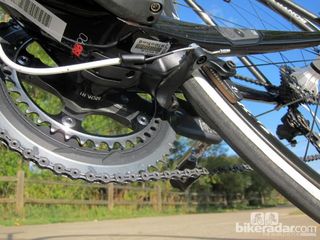
The rear brake isn't accessible while riding
Weight is competitive, at 154g apiece with mounting hardware, but they're visually chunky and cheap looking. The associated hardware feels rather low-rent, too, with a lowly steel M6 locknut used for the rear cable anchor and soft aluminum pad hardware that easily takes a set, making it difficult to get a good adjustment.
More to the point, they don't work as well as they should. The flex-free mounts yield a firm lever but high-end power is lacking, exacerbated by the stock Bontrager cork pads' so-so initial bite. We had to squeeze awfully hard to rein in speed when hurtling down some of our most familiar descents. In addition, the pivots bind if they're tightened down too much. Loctite on the threads is a must.
Even the brakes' placement complicates matters. None of the pad fixing screws can be readily accessed on the bike – meaning you have to readjust the cartridges every time you swap pads – and it's virtually impossible to sight the rear brake pads on the rim while simultaneously squeezing the lever. Adding even more fuel to the fire is the fact that they simply don't look very high-end, either.
Trek has managed to integrate aerodynamic performance into the new Madone while impressively maintaining all of the old bike's most important characteristics: weight, stiffness, ride quality, and handling. The devil is in the details, though, and we can't help but feel a few important ones were overlooked here.
Price: US$3,629.99 (frame, fork, Cane Creek IS-2 headset, Bontrager Speed Limit brakes, and Bontrager Ride Tuned Carbon seatmast cap) Weight: 6.54kg (14.42lb, 52cm H1, as built, without pedals); 1,000g (frame only with water bottle bolts, rear derailleur hanger, and housing stops); 330g (fork only without compression plug, 180mm steerer) Available sizes: H1: 50, 52 (tested), 54, 56, 58, 60, 62cm; H2/WSD: 47, 50, 52, 54, 56, 58, 60, 62, 64cm Cyclingnews verdict: 3 ½ stars More information: www.trekbikes.com
Complete bicycle specifications
Frame: Trek Madone 6-Series Available sizes: H1 fit: 50, 52 (tested), 54, 56, 58, 60, 62cm; H2 fit: 47, 50 52, 54, 56, 58, 60, 62, 64cm Fork: Trek Madone KVF full carbon Headset: Cane Creek Forty integrated, 1 1/8-to-1 1/2" tapered Stem: Bontrager Race X Lite Handlebars: Bontrager Race XXX Lite VR-C Tape/grips: Bontrager Cork Front brake: Bontrager Speed Limit Rear brake: Bontrager Speed Limit Brake levers: Shimano Dura-Ace STI Dual Control ST-7900 Front derailleur: Shimano Dura-Ace FD-7900 Rear derailleur: Shimano Dura-Ace RD-7900 Shift levers: Shimano Dura-Ace STI Dual Control ST-7900 Cassette: Shimano Dura-Ace CS-7900, 11-25T Chain: Shimano Dura-Ace CN-7901 Crankset: Shimano Dura-Ace FC-7900, 53/39T Bottom bracket: Enduro Pedals: n/a Wheelset: Bontrager Aeolus 3 tubular Front tire: Bontrager R3 Road, 700x23c Rear tire: Bontrager R3 Road, 700x23c Saddle: Bontrager Affinity RXL Seat post: Bontrager Ride Tuned Carbon

Thank you for reading 5 articles in the past 30 days*
Join now for unlimited access
Enjoy your first month for just £1 / $1 / €1
*Read any 5 articles for free in each 30-day period, this automatically resets
After your trial you will be billed £4.99 $7.99 €5.99 per month, cancel anytime. Or sign up for one year for just £49 $79 €59

Try your first month for just £1 / $1 / €1
New disc brake-equipped Giant Trinity TT bike spotted at Tour de Romandie
POC Aspire cycling glasses review: A sturdy and stylish modern classic
Lauren Stephens wins Tour of the Gila
Most Popular

Trek Madone 9.9 Review

In a country where “awesome” and “amazing” are standard vocabulary, how are you supposed to pick the right superlative to describe an extraordinary bike? That’s when it’s time to rely on the cold, hard facts. But are they enough to leave us entranced with the Trek Madone 9.9?

Trek aren’t known for their tunnel-vision so they’ve expanded their horizons (and ours) by not exclusively offering the Madone as a race-ready bike, but also offering it in the more upright and comfy H2 geometry. In fact, we can testify to the comfort of the H2 variant.
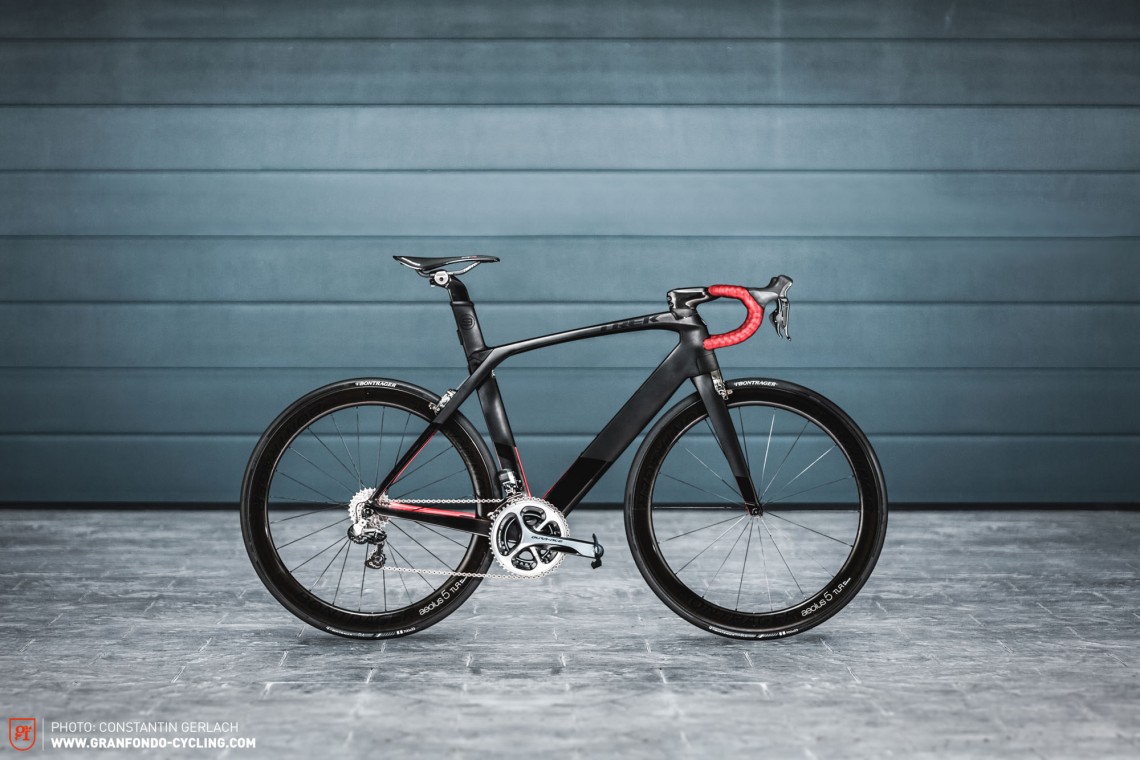
Over in the land of opportunity, the bike developers at Trek’s HQ in Waterloo, Wisconsin, have created a veritable piece of art that goes by the name of the Trek Madone 9.9. By its own claims, it unites the elements of power, aerodynamics, performance and integration to the max, so we were curious to discover the truth in these assertions.
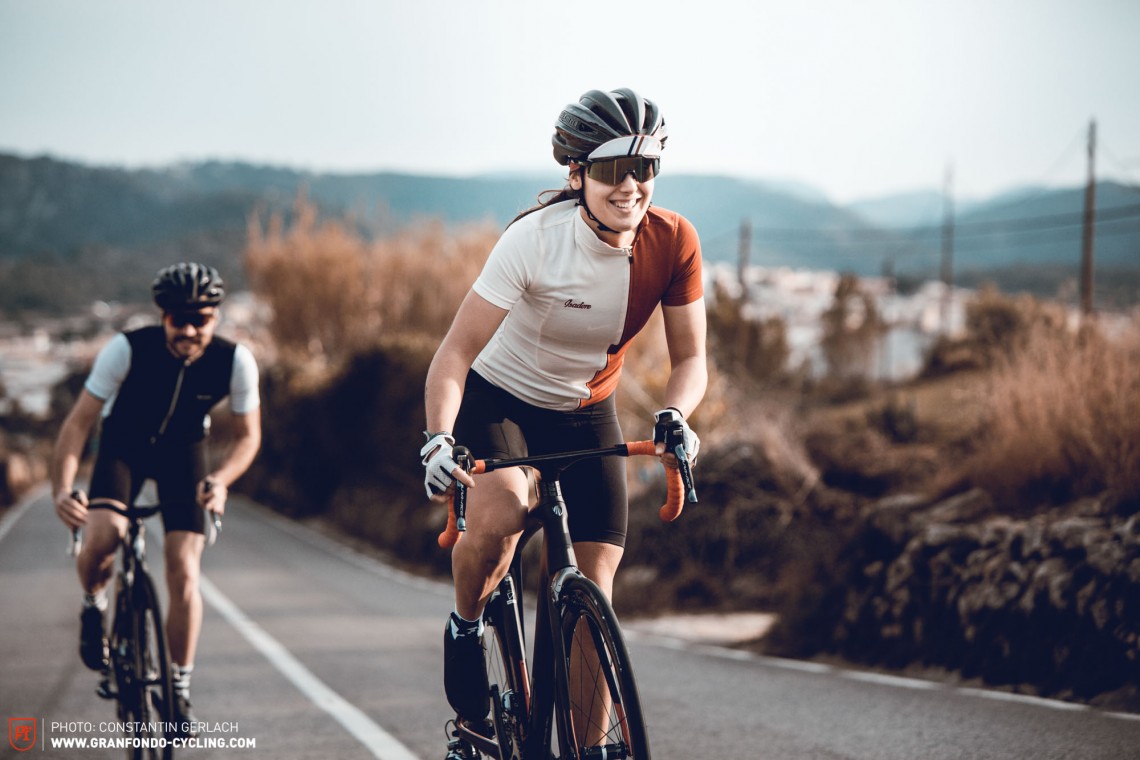
True to its word, no other bike in this group has achieved such a holistically perfect system integration. The list of its technical finesses is a long one. It has an IsoSpeed decoupler that creates vertical compliance by decoupling the seatpost from the top tube and seatstays for added comfort. The components are well chosen, and include an integrated bar and stem, shaped for aerodynamic performance. The front brake is integrated with the fork and headtube. Despite this integration, so-called “vector wings”, hidden beneath a cover at the bottom of the headtube, allow 65 degrees of turn to comply with government regulation. With a spec that’s unlikely to give room for complaint, the Madone appears to be onto a winner.
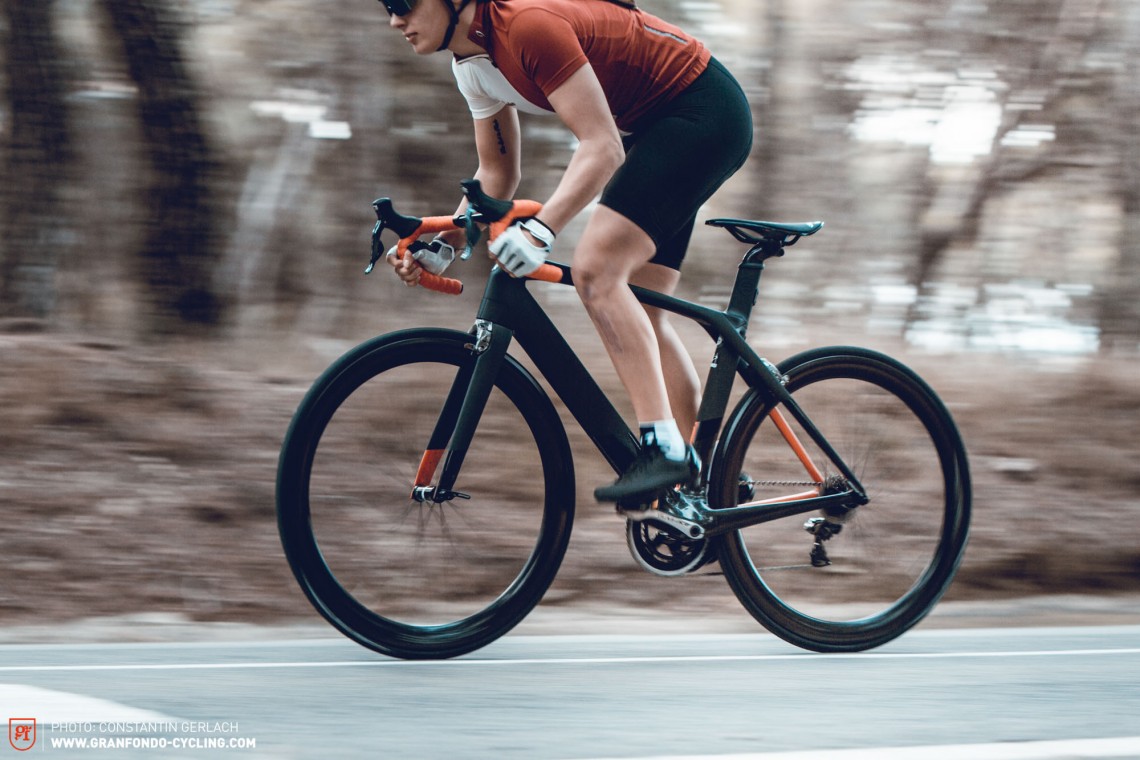
Even away from the stand, the Madone doesn’t disappoint, knowing the exact definition of a great ride. Thanks to its high levels of rigidity, the Madone is ultra efficient. Road chatter leaves the bike unfazed, and comfort showed no deterioration over the course of a long day (thanks IsoSpeed!). Super precise, it’s a bike that can take any amount of lean on a corner, any strength side winds as well as any pace and still come out shining. The Madone is a surprisingly good climber, although the wide bars aren’t the comfiest to grip.
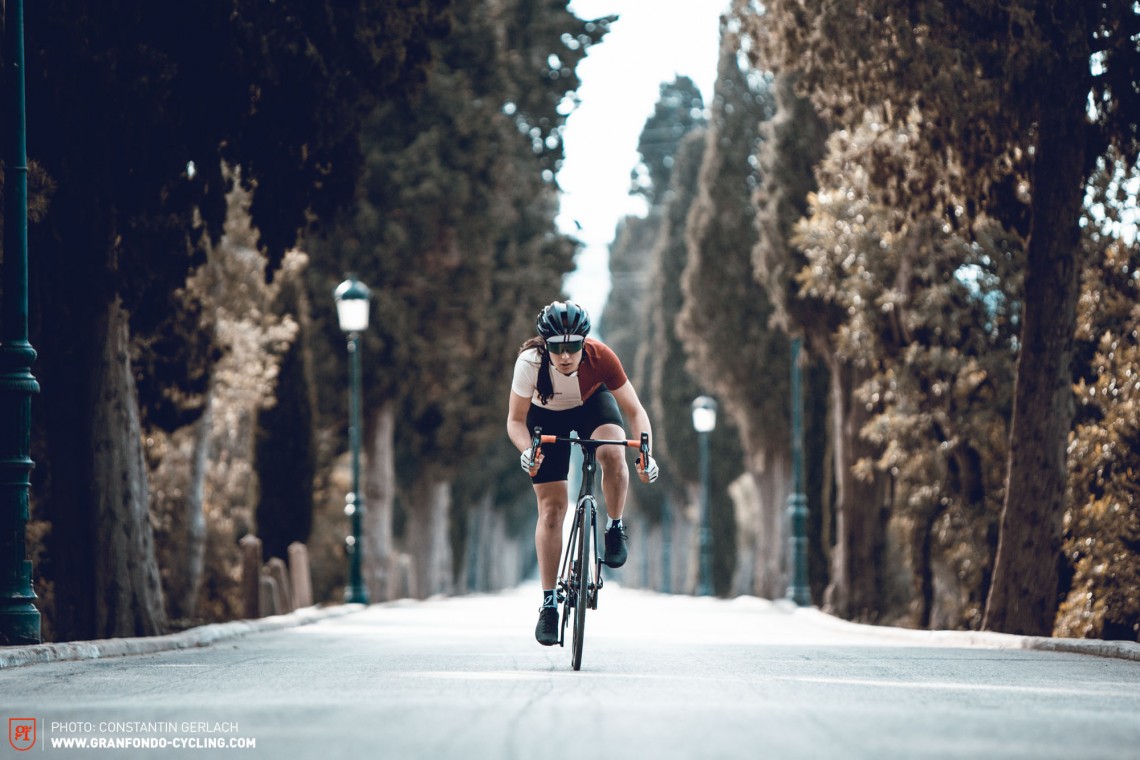
It’s definite: Trek have achieved full integration, but integration can come at the cost of fine-tuning and fixing. However, if you’ve got the budget for this bike, who wouldn’t trust its care to a reputable service centre?
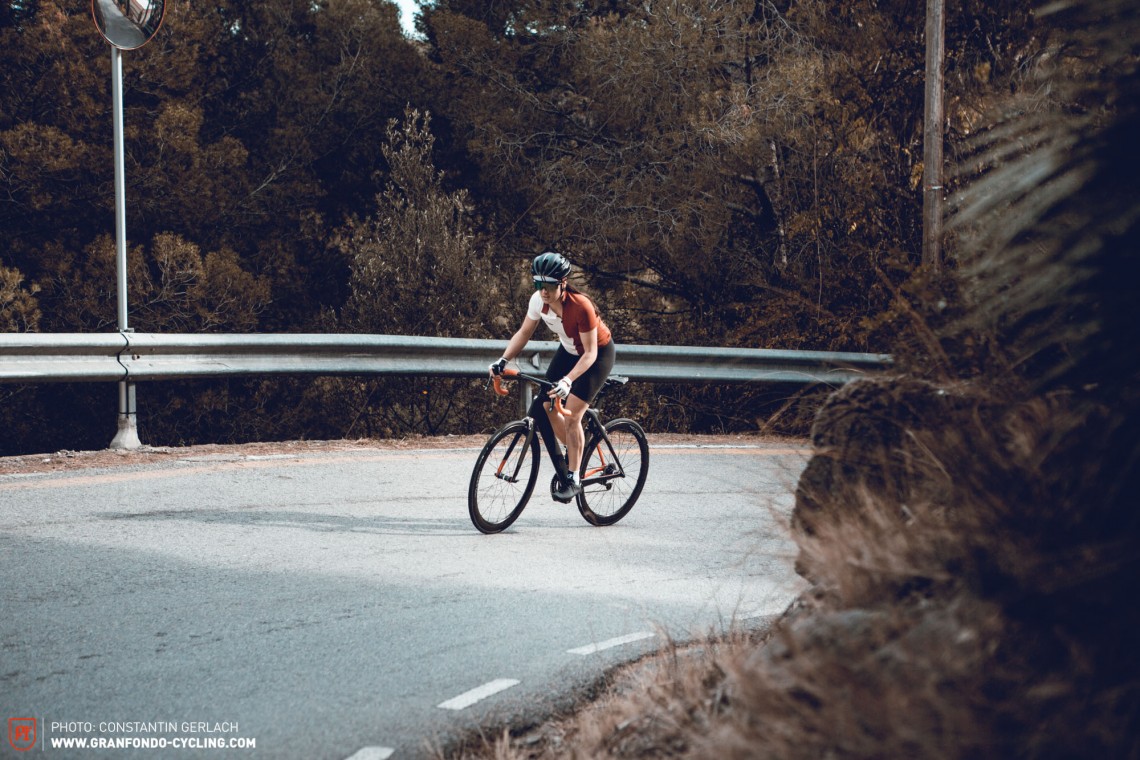
Details dof the Trek Madone 9.9
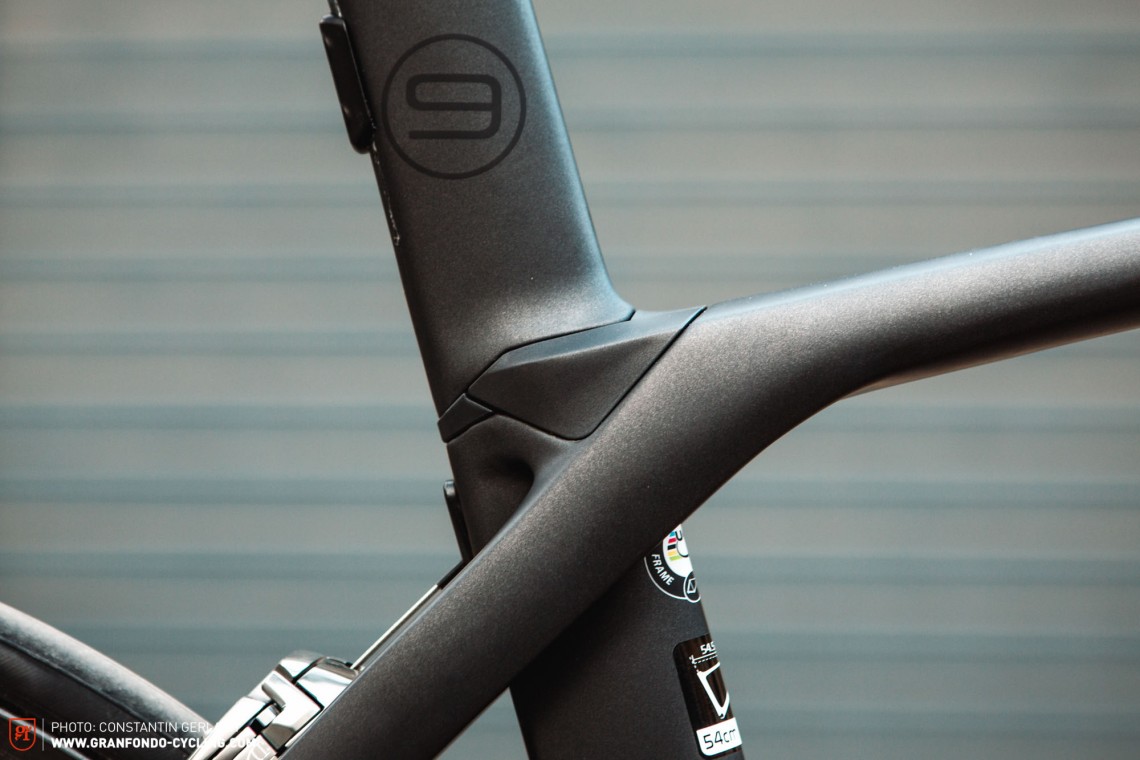
Specifications of the Trek Madone 9.9
- Drivetrain: Shimano Dura Ace Di2 2×11 SP
- Gears: Chainrings: 50/34 | Cassette: 11-28
- Brakes: Madone Aero
- Tyres: Bontrager R4 Hard-Case Lite
- Wheelset: Bontrager Aeolus 5 D3
- Weight: 7.05 kg
- Price: € 12,999
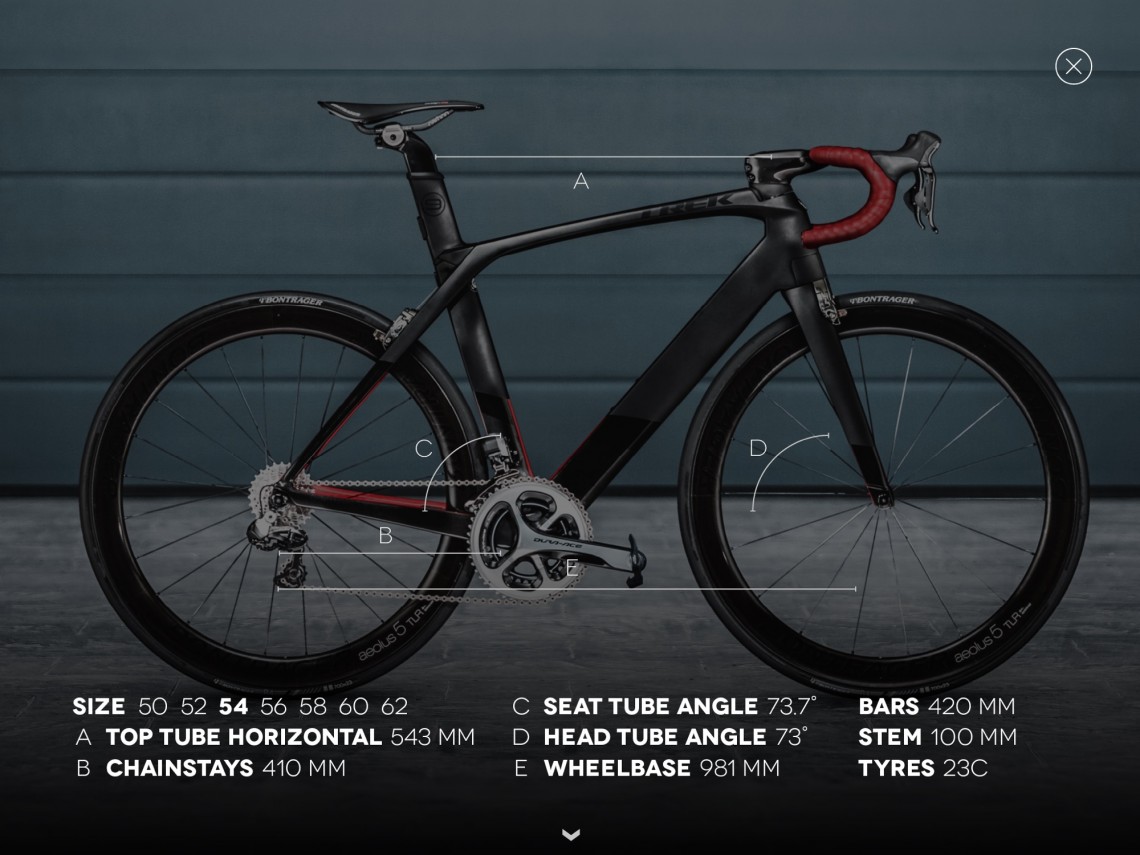
The spec list reads equally as well, and the compact cranks offer enough range to play in the high mountains. It might sound paradoxical for an aero race bike, but it’s the truth: in Trek’s mind the Madone was designed as the ultimate bike for amateurs with high standards, and they have succeeded. Of course, to the delight of many (and the anguish of many others), the Madone can also be customized in their pretty pricey Project One configurator.
Who is the Trek Madone 9.9 made for? Depending on spec and geometry choice, the answer is much like a pendulum: from the pro peloton to those further back, from design-savvy riders to technological-feature hunters and those who’re after the best of the best. In short: everyone, and that’s exactly why it comes as no surprise that the Trek Madone won the GOLD Award at the internationally renowned Design & Innovation Award 2016.
- Exclusive design with flawless integration and great spec
- Masses of room for customization thanks to Project One
- Superb handling
- Complex by nature so potentially not the cheapest for repairs
For more information check the Trek website .
About the test
With 10 test riders descending on Barcelona from across the globe, we dedicated 9 days to pushing this season’s most exclusive and exciting and exciting bikes to their limits in a one-of-a-kind group test. Each rider brought his or her own specific experience to the process, with a test team comprised of four women and six men, including former Tour de France riders, biomechanics, bike shop owners, tour guides and amateur riders. In short: a gathering of highly experienced and well-versed road riding enthusiasts. Our goal was a simple one, to give you all the information needed to make you a winner: Why? Becuase life’s too short to ride the wrong bikes.
For an overview of the test fleet head to the main article: The 10 most exclusive and exciting bikes in Test
All bikes in test: Storck Aernario Platinum G1 | Specialized S-Works Venge | Ritte Ace | Focus Izalco Max Disc“ | Festka One LT Dazzle | Crema Doma | Cervelo C5 | Canyon Aeroad CF SLX 9.0 | Bianchi Specialissima
Words: Markus Ybanez, Robin Schmitt, Emmie Collinge Photos: Constantin Gerlach, Klaus Kneist, Christoph Bayer
Did you enjoy this article? If so, we would be stoked if you decide to support us with a monthly contribution. By becoming a supporter of GRAN FONDO, you will help secure a sustainable future for high-quality cycling journalism. Click here to learn more .
You may also like

The perfect fit? Bike fitting put to the test

FOCUS PARALANE 8.9 – Back to the roots yet up to date?

2024 GIANT Defy Advanced SL – More than just a pretty face?

Canyon Endurace CF SLX 8 AXS Aero – All in the name of speed and distance?

Specialized S-Works Roubaix SL8 – A gravel wolf in all-road clothing?

Endurance road bikes with an adventurous spirit – Shootout of four of the hottest...

- Rider Notes
2016 Trek Madone 9.5 H2 Compact

A carbon frame aero bike with ultra high-end components and rim brakes. Compare the full range
For This Bike
View more similar bikes →
A bike with lower gearing will be easier to ride up steep hills, while a higher top end means it will pedal faster down hills.
Madone 9.5 H2 Compact
Similar Bikes
(descending)
Add custom gearing
5'1" – 5'5"
5'3" – 5'7"
5'5" – 5'9"
5'7" – 6'0"
5'10" – 6'2"
6'0" – 6'4"
6'2" – 6'5"
🐐 Estimated
Do you have this bike? Help other riders make a decision about which size will work for them by sharing your own size and fit notes. Report your fit

May 2017 · Robin Schmitt, Manuel Buck, Benjamin Topf
Trek didn’t hold back when it came to advertising the Trek Madone 9.5 Ultegra Di2, calling on dramatic hyperbole to sing its praises: …
Read Review

Aug 2016 · Colin Levitch
The new Madone is one of the most comfortable and integrated road bikes on the market, but the fully hidden cables are sure to be a headache in the long run. Buy if you want a race bike that won't leave your body beaten and battered at the end of the day
IsoSpeed decoupler makes for unrivaled ride quality, real world aero gains
You're going to have to replace the cables and housing someday

Jul 2016 · Andre Cheuk
Canadian Cycling Magazine takes a look at the custom Trek Madone of Fabian Cancellara, at the 2016 Tour de France.
May 2016 · VeloNews.com
The new Madone is cycling’s Bugatti Veyron — an exotic beast that looks like it’s moving fast even when it’s standing still. This bike begs for high-speed

Feb 2016 · Dan Cavallari
We take a close look at how these two speedsters perform to see which one is the best aero setup.

Aug 2015 · Mat Brett
Stunningly good bike that offers a fabulous mix of speed and comfort, although, as usual, the top-end tech comes at a price
In the build-up to this year's Tour de France we see yet another bike launch from one of the big players of the industry. This time it's Trek with the launch of the company's 2016 edition, 9 Series Madone. CyclingTips' Dave Everett was in The Netherlands for the launch and wrote this about his first impressions of

Jul 2015 · R BA
Updated Madone targets aerodynamics and comfort

Last updated June 29 Not listed for 2,494 days

- Forum Listing
- Marketplace
- Advanced Search
- Classic Forums
- General Cycling Discussion
2016 Trek Madone aero road bike revealed

Attachments

- ?
- 205.2K members

Top Contributors this Month


- ALL (67 Forums)
- WHEELS & TIRES
- SPECIALIZED
- CYCLOCROSS BIKES
- TIRES & WHEELS
Trek Madone 5.2 Road Bike

- OCLV 120 Carbon Frame
- Bontrager Race X Lite
- OCLV 120 Carbon Fork
- Bontrager Race Lite Wheels
- Shimano Ultegra Rear Derailleur
- USER REVIEWS
Light, stiff, gives back the power you put in. Low. Long-lasting. I am writing about the Madone from about 2007 which has a horizontal top bar. I bought it from the Japanese equivalent of ebay because I wanted a bike with a short head tube. Rider body drag is the biggest component of drag apparently at about 60% of total drag, so rather than an aero frame with can shave a percent or two off the 9% of frame drag with a modern aero frame, I would rather get down a degree or two or ten lower, especially now that I have worked out how cyclists used to pedal: forwards and backwards, rather than the current stomp stomp, which makes it much easier to get down low. The other advantage of a low "non-compact" frame is that it forces me to cognise my belly fat. It is like wearing tight jeans. You know when you have eaten too much the day before. This is my second low "aggressive" frame. My other is a Look KG 386 with a similar sized (less than 14cm in the medium 54cm size) head tube. The French Look has a perfectly damped feel. When I go over a bump in the road the vertical movement disappears in a swiftly diminishing suave sinusoid. This Trek however has more bounce. I go over a bump in the road and it almost feels like I am going to take off. The difference in springiness is an advantage however when it comes to pedalling. The Look feels like it is absorbing some of the power I put into the cranks whereas the Trek makes me feel like all power in bounces back. It has more mechanical machismo making the Look feel like a sophisticated stale baguette.
A little bit bouncy. If you don't use the shifters the grease inside may get sticky preventing you from changing down the cassette to the highest gear. Rinsing with lots of brake cleaner and relubricating with a PTF containing lubricant should get the shifters clicking again.
Very smooth and overall sturdy bike for mountain riding and even just casual riding throughout the day. Definitely recommend to anything with an interest or hobby in bike riding. It withstood the test of wear and tear when I used to ride to project sites for my Brick Pavers business.
None that I can think of.
ood smooth shifters. Big wheels, ideal for cruising at high speed. Shocks eat up bumps. Well built. Repositionable handlebars. Good on flat roads, has decent off-road capabilities too. Bakersfield Pro Concrete Pumping
None so far.
Great choice of bike. Light weight, very stiff and good handling. Never encountered trouble for almost a year upon purchasing. Highly recommended from Bathroom Tile Company.
Price? Not really. Let’s be honest, I didn’t have to get a Madone, I chose to get a Madone and isometimes you have to pay to play. Bike is actually a 2006.
custom stickers | print stickers | business printing | printing company
Excellent handling bike that rolls with very little road buzz.
This bike is extremely maintenance intensive due to design flaws in the bottom bracket and headset. It is worse than owning a Porsche or a British sports car and I've owned both and worked on both. You're looking at overhauling the BB at 500-750 mile intervals and replacing the non-drive side bearing at the least. This bike had so many overhauls over 13K miles that even the oversize bearings were too loose a fit. You're looking at 1500-1800 mile interval for the headset and replacing the upper bearing if not both. You definitely better learn how to work on your bike or you're going to be spending $$$'s at the bike shops. The wheels are a low quality wheelset and I ended up having to replace the wheelset after less than 3K miles. After finding numerous flaws with the bike Trek FINALLY replaced it with another model.
great bike second bike i have got first worth 200£ it reacts to everything in ease and speed.
Has a noise to it don't no where its coming from sounds like the seat thats it
just bought this bike it was on sale in intersport 50% off 3450€ to 1700€ it had ben sat there for two years. great find oct 2016 Very Light Reactive for speed sprint I've been riding now 4 months and have my avenge to 35ks an hour live in france lots of hills Limoges started off average 22ks got to 28ks but flying now. recommend to anyone
Strong, solid, well-built and designed machine
As everyone else has mentioned, the saddle stinks. In fact, I can't imagine a normal human being being comfortable on the thing. That being said, think of a saddle as a pair of shoes. You'll want to find something more specific to YOU! As far as the bike itself, it's wonderful! TREK consistently designes equipment that's superior to most. They also stand behind what they make in ways that many don't. I have a little over 10,000 miles on my Madone, and have replaced only tires and the bottom bracket (-bottom bracket at 8500 miles). Both of these components are "expendables". There are "heavy-duty" brackets that you can use, but then the emphasis is on heavy. Be content with the standard set. This is not my first Trek. They've never disappointed, and this Madone is no exception. It's stable and dependable, with no kinky surprises that you discover on some fast downhill (-had this happen once on another brand). You won't be disappointed. -Oh, and I'm a 69 year old veteran rider with a lifetime of riding experience (-still have yet to find that hidden motor that so many talk about).
Similar Products Used:
Giant, Fuji, and many others
The performance is great on this bike. Light, stiff and very responsive. A great bike to ride.
I replace the Bontrager wheelset after about 10K miles with a Flo 30 wheelset. Seat mast kept slipping till the shop finally used a special grease and discovered that the seat mast bolt should be torqued to 7 N instead of 5 N. The bottom bracket is the biggest weakness of the bike. My bearings lasted about 500-600 miles and you have to overhaul the BB about every one to two months or after riding in the rain. In fact, I won't even ride it when the roads are wet due to having to O/H the BB. A new Trek bearing set with a dust seal got about 800+ miles if overhauled at about 400 miles. Now the frame cups have worn to the point where I now need special Trek oversized brackets.
Performance is outstanding, but I can't give it a high score because of the serious design flaw of the bottom bracket and the poor wheelset. The BB makes for a much more maintenance intensive bike.
Light Weight, very stiff and an all round option
Wheelset, bontrager stock saddle and little bit of shifting issues
My first bike and am overall very happy since I have switched to carbon wheels, it is a good all round bike fast on the flats and climbs well as well. Trek should have given saddle options as the stock bontrager is a waste. Changing it with Selle SMP. Shifting needs minor adjustments many a times on the fly
Get the latest road bike reviews, news, race results, and much more by signing up for the Roadbikereview Newsletter
Hot Deals See All Hot Deals >>
Get the latest roadbike reviews, news, race results, and much more by signing up for the Roadbikereview Newsletter
- EDITORIAL REVIEWS
- CLASSIFIEDS
ABOUT ROADBIKEREVIEW
- TERMS OF USE
- PRIVACY POLICY
- ADVERTISING
VISIT US AT
© Copyright 2024 VerticalScope Inc. All rights reserved.
NEW! YOUR LOCAL RUNNING DROP
Get after it with nearby recommendations just for you.
BEST WEEK EVER
Try out unlimited access with 7 days of Outside+ for free.
Start Your Free Trial
Powered by Outside
Reviewed: Trek Madone SLR 6 Disc Speed
It’s fun, it’s fast—and it delivers one hell of a ride, but with quite the hefty price tag..
The Trek Madone SLR 6 is a head-turner of a bike that is fun to ride—but it comes with a hefty price tag for a mechanical bike.
Fast, responsive, and super-stiff
Handles well, even in tight corners
The $6k price tag—when it’s “only” mechanical—stings
19 lbs. 2 oz.
New perk! Get after it with local recommendations just for you. Discover nearby events, routes out your door, and hidden gems when you >","name":"in-content-cta","type":"link"}}'>sign up for the Local Running Drop .
Trek is one of the most recognizable bike brands in the world and the Madone has been one of its most successful bikes over the last two decades. With the Madone SLR 6 Disc Speed nothing changes there and it is a pure joy to ride. Looking for a bike to remind you *just* how fun road bikes are to ride? Say hello to the Madone. With its Speed Concept Mono Bar Extension aero bars you can easily transform it into a race machine or remove them for group rides when you want a more pure road look and feel. Bontrager Aeolus Pro 5 wheels, Shimano Ultegra drivetrain, and Shimano Ultegra hydraulic disc brakes help round out a pretty sweet package.
Related: Triathlete’s 2020 Road Bike Buyer’s Guide
Trek Madone SLR 6 Disc Speed: The Ride
From the moment you first ride the Trek Madone SLR 6 Disc Speed you know you’re in for a treat. It looks fast, it feels fast, it is fast. Trek is one of the most recognizable bike brands in the world and the Madone has been one of its most successful bikes over the last two decades. With the Madone SLR 6 Disc Speed nothing changes there and it is a pure joy to ride. Its aero-geometry is, unsurprisingly, well thought out and it’s a bike that begs to be ridden fast. Standing up out of the saddle and laying down some top-end power will reward you with a burst of acceleration that’ll have you grinning from ear to ear: this is bike riding at its finest. The frame beneath you is stiff yet fast and responsive. That said, this isn’t a racing machine that lacks comfort. It handles well—you feel stable—and you can lean it through tight turns and corners with relative ease.
Trek Madone SLR 6 Disc Speed: The Good
The Trek Madone SLR 6 Disc Speed is intelligently designed and easy to ride. It’ll remind you of why you first fell in love with riding bikes in the first place. For triathletes looking for a road bike that is both fast, comfortable, and easy to train on, you will not be disappointed. The Shimano Ultegra hydraulic disc brakes deliver sharp, crisp braking and all brake and gearing cables are neatly routed through the frame to maximize aerodynamics. Riding in the drops is incredibly fun on this bike—in fact, it almost begs you to get down in the drops and stay there, especially on more technical descents. Speed and comfort do not feel compromised in this position.
Trek Madone SLR 6 Disc Speed: The Medium
When you’re parting with more than $6,000 for a bike, we think it’s more than fair to expect electronic shifting, but instead here you’ve got a Shimano Ultegra mechanical set-up, which seems a little surprising at this price point. Obviously, you don’t necessarily expect an aero road bike to be the greatest climbing machine, but we found the 50/34 compact gearing helped improve that considerably.
Trek Madone SLR 6 Disc Speed: Conclusions
This is a bike that’s easy to fall in love with on first ride, especially if you’re someone who loves riding hard and fast. It’s unashamedly aero and will tick all the boxes for triathletes looking for something close to tri speed on a road bike. You will definitely not be disappointed with how it handles and accelerates, but you could feel disappointed that you don’t have electronic shifting. If you’re OK with that (for this price tag), you’re going to have a lot of fun pedaling this bike to many PRs.
Popular on Triathlete

Join Outside+ to get access to exclusive content, 1,000s of training plans, and more.
Healthy Living
- Clean Eating
- Vegetarian Times
- Yoga Journal
- Fly Fishing Film Tour
- National Park Trips
- Warren Miller
- Fastest Known Time
- Trail Runner
- Women's Running
- Bicycle Retailer & Industry News
- FinisherPix
- Outside Events Cycling Series
- Outside Shop
© 2024 Outside Interactive, Inc
Trek Madone SLR 7 Gen 7 review - very fast and very expensive
The latest Madone may have a hole through the seat tube but we couldn't find any in its performance
- Sign up to our newsletter Newsletter

The Trek Madone is an absolute speed weapon. The deep-section tubes with the radical-looking cutout help, as does the newly designed handlebar, which is narrow and provides good wrist support for the ‘aero-hoods’ position. And then there are the 51mm deep Bontrager Aeolus Pro wheels. The handling is incredibly fast, responding to the smallest shift in weight and the tiniest tweaks of the bars, and ride quality is so impressive that it’s almost possible to overlook things like the narrow tires and ungenerous clearance - but you can’t ignore the price. If you have the budget and want a WorldTour-level race machine with exceptional handling and ride feel, this is the bike.
Super smooth ride
Light for an aero bike
Striking aesthetics
Limited adjustability
No power meter
You can trust Cycling Weekly. Our team of experts put in hard miles testing cycling tech and will always share honest, unbiased advice to help you choose. Find out more about how we test.
- Construction
Value and conclusion
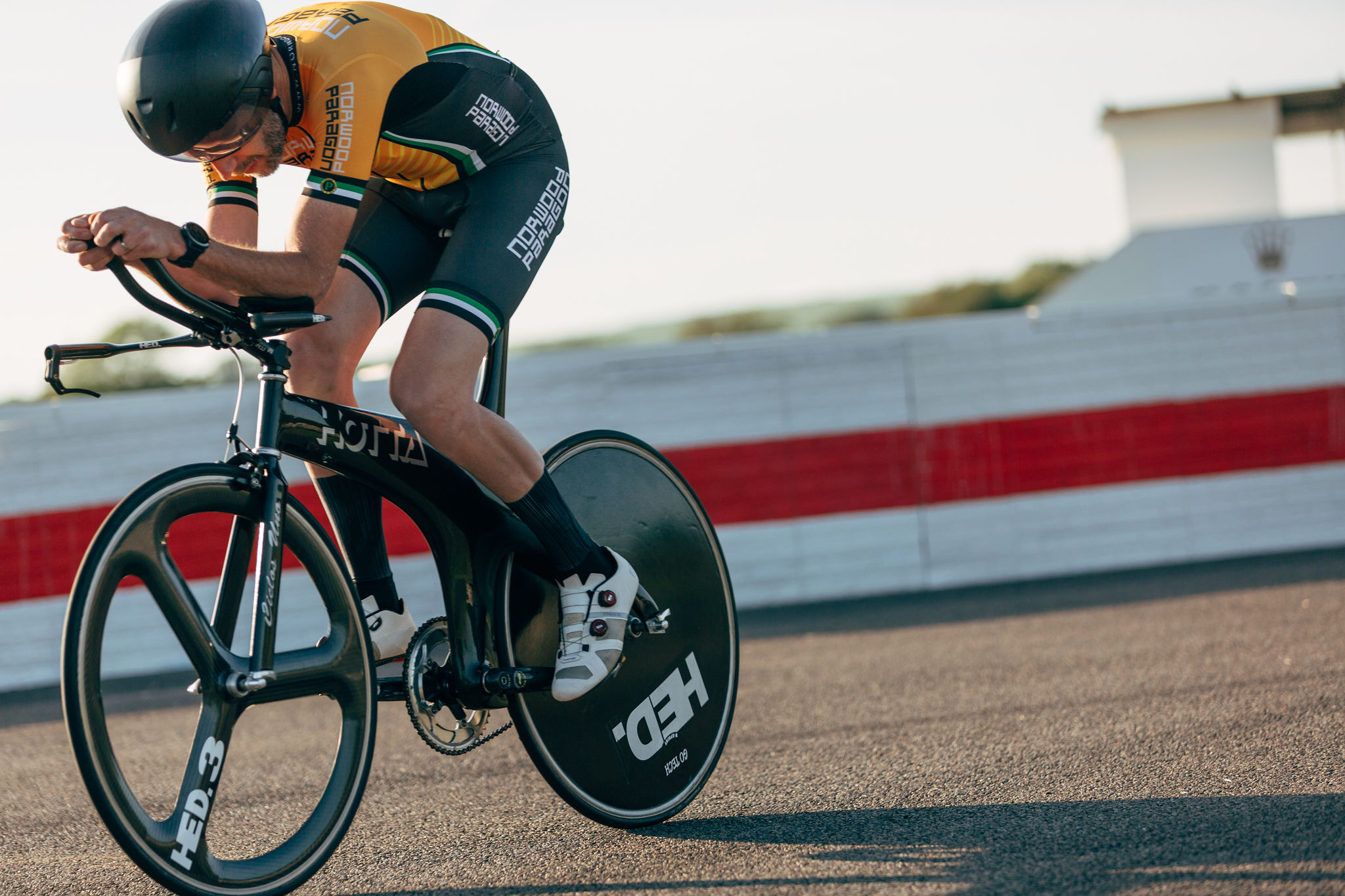
For this latest Gen 7 version of the Madone, Trek’s aero bike, the US brand removed the IsoSpeed Decoupler of the previous Gen 6 model and left, in its place, a big hole.
OK, it’s not the crude, reductionist approach it sounds like.
The old bike’s micro-adjustable suspension system at the top tube/seat tube juncture added weight and was mostly redundant since Trek discovered most riders would ‘set and forget’.
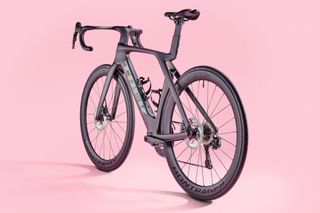
And by radically reengineering the frame Trek claims to have saved 300g, and says the new bike is almost 20 watts faster than its predecessor, which equates to 60 seconds per hour when ridden at 45kph. It looks radical, too - always a good thing for a new bike.
In our 2023 Race Bike of the Year grouptest we awarded the Madone 'best aero bike' against competition that included the Cervélo S5, the Canyon Aeroad and the Giant Propel.
However, over $9K / £10K for an Ultegra bike has to be unchartered territory - so how does it compare overall to the best road bikes ?
Trek Madone 7 Gen 7: construction

Let’s peer a bit more closely into that hole or, to give it its real name, IsoFlow. The aerodynamic explanation for it is: “It’s a way to direct some high energy flow into a low energy region of the bike.” What that means is that the seat tube area creates a disproportionate amount of drag and the hole helps to dissipate this by adding what Trek calls a “jet of fast moving air.”
It turns out that only half of the claimed watt saving comes from the IsoFlow hole. Trek has entered the integrated cockpit wars (along with Colnago, Canyon, Cervélo et al) with a completely new and very slick-looking design but it’s neither adjustable nor V-shaped: according to Trek it saves watts by changing rider position rather than via the aerodynamic properties of the cockpit itself.
A standard 42cm bar becomes 39cm at the hoods and 42cm at the drops and there’s a backsweep so that a flat-forearms aero position on the hoods becomes very aero indeed.
There are 14 different combinations available and, since the backsweep gives the bar a shorter reach, it’s important to get the right one - if you’re like those of us who rode this bike, you’ll need a longer stem. You can change this at point of purchase at no extra cost, Trek told us, or the 1 1/8in steerer is compatible with a non-integrated stem and bar (though the frame is electronic groupset only).
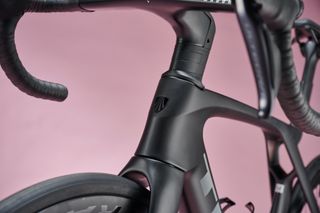
The same goes for the seatmast. The cutout in the seat tube leaves less room for a long seatpost and less adjustability (around 6cm minimum to maximum) so if you are long-legged but prefer a smaller frame you may need the tall version that comes with the size 56 upwards (as I ideally would have done). There are also two offsets available.
Our size 54 with a standard short mast could only manage a maximum saddle height of 74cm and the reach felt very short with the 90mm stem cockpit it comes with.
The latest geometry is called H1.5 (halfway between the old H1 race and H2 endurance). The reduced reach combined with the shorter reach of the swept-back bar works very well for that super aero hoods position, but it does feel surprisingly short. The kamm-tailed rear of the stem is much closer to your knees than you’d expect.
The new SLR bikes are all made from Trek’s 800 OCLV carbon - from the 105-equipped SLR 6 up to the flagship SLR 9 - and are impressively light, especially compared with other aero bikes such as the Cervelo S5. Trek says this is its lightest ever disc Madone.
There’s clearance for 28mm tires max, which is tight by modern standards. This model comes with Bontrager Aeolus Pro 51 tubeless-ready wheels, set up with Bontrager R3 Hard-Case Lite 25mm tires and inner tubes - again, surprisingly narrow.
Despite the fact that the fit wasn’t optimal - I could have done with the size up - the ride quality of the Madone is absolutely incredible. That’s the first thing that strikes you, or rather doesn’t strike you.
Aero bikes used to supply a harsher ride simply because deep, bladed tubing doesn’t flex like round tubing. This was undoubtedly the reason why Trek bolted the IsoSpeed decoupler onto the Madone two iterations ago. So you might expect that with its suspension system gone, the latest bike might have gone backwards in comfort. Not a bit of it.
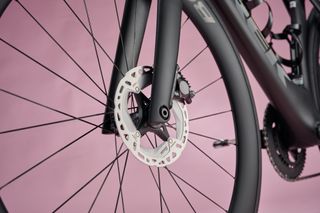
It feels like a coiled carbon spring - full of potential energy and floating over bad road surfaces seemingly without any effect on its speed. And this is on 25mm tires that aren’t even the best (at this price they really ought to be).
The handling is also exactly right. The shortish 90mm stem section of the cockpit could have made it a little twitchy, but thanks to the sweeping shape I found my weight sufficiently over the front wheel in the hoods position, and steering was fast but balanced on descents and tight corners.
So it passes ‘comfortable’ and ‘fast’ with flying colors (actually Deep Smoke for this one).
At 7.5kg it’s light for an aero bike - or any disc brake bike - and it leaps up hills as if it weighs even less. I was so impressed with its performance that I kept forgetting Trek also has the Emonda climbing bike. The next Emonda has its work cut out (pun intended).
Finally, stability in crosswinds. There’s one particular gateway on my test loop where any bike not designed for big yaw angles will be gusted and the Trek was indeed blown sideways slightly - but not alarmingly considering the deep wheels and frame tubes.
This bike is incredibly good but it’s also incredibly expensive. It’s a full $1,000 / £1,000 more than the equivalent outgoing Gen 6 Madone SLR 7, and you’d have to look hard to find a more expensive Ultegra Di2-equipped bike from the other mainstream brands.
The Canyon Aeroad CFR with Dura-Ace costs $8,999 / £8,799, while the Cervelo S5 with SRAM Force AXS costs $9,000 / £9,200. The Giant Propel Advanced SL1 also with SRAM Force costs $8,000 / £8,999.
You might also reasonably expect a power meter at this price - those three bikes all come with them - but it’s just the regular Ultegra crankset here.
So the price is stratospheric but compared with the current aero bikes I’ve ridden so far including the Colnago V4RS , Canyon Aeroad SLX , Cervelo S5, Tarmac SL7 and Pinarello Dogma F, the ride quality is superior.
- Frame: 800 Series OCLV carbon
- Fork: KVF carbon, tapered steerer
- Groupset: Shimano Ultegra Di2
- Wheels : Bontrager Aeolus Pro 51
- Tires : Bontrager R3 Hard-Case Lite 25mm
- Cockpit: Madone integrated
- Seatpost : Madone aero internal
- Saddle: Bontrager Aeolus Elite
- Weight: 7.5kg
- Contact: www.trekbikes.com
Thank you for reading 20 articles this month* Join now for unlimited access
Enjoy your first month for just £1 / $1 / €1
*Read 5 free articles per month without a subscription
Join now for unlimited access
Try first month for just £1 / $1 / €1
Get The Leadout Newsletter
The latest race content, interviews, features, reviews and expert buying guides, direct to your inbox!
Simon Smythe is a hugely experienced cycling tech writer, who has been writing for Cycling Weekly since 2003. Until recently he was our senior tech writer. In his cycling career Simon has mostly focused on time trialling with a national medal, a few open wins and his club's 30-mile record in his palmares. These days he spends most of his time testing road bikes, or on a tandem doing the school run with his younger son.

Coffee connoisseur Adam Becket delves into the storied yet mysterious relationship between cycling and the original energy drink
By Adam Becket Published 28 April 24

Riding a folding bike marks you out as a crank, especially with the addition of a monocle and dinner jacket, recalls the Doc
By Michael Hutchinson Published 28 April 24
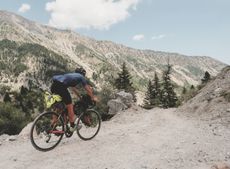
The ultra-distance benchmark that pits riders against a 4,000km self-supported Europe-wide trek reaches double figures
By James Shrubsall Published 27 April 24
Useful links
- Tour de France
- Giro d'Italia
- Vuelta a España
Buyer's Guides
- Best road bikes
- Best gravel bikes
- Best smart turbo trainers
- Best cycling computers
- Editor's Choice
- Bike Reviews
- Component Reviews
- Clothing Reviews
- Contact Future's experts
- Terms and conditions
- Privacy policy
- Cookies policy
- Advertise with us
Cycling Weekly is part of Future plc, an international media group and leading digital publisher. Visit our corporate site . © Future Publishing Limited Quay House, The Ambury, Bath BA1 1UA. All rights reserved. England and Wales company registration number 2008885.
- MAGAZINE OFFERS
- BIKE INSURANCE
- Best Products
- Maintenance
- Accessories
- Long-Term Reviews
- BikeRadar Podcast
- First Look Friday
- Bike of the Week
- Tech Features
- Routes and Rides
- Bike Galleries
- BikeRadar Bargains
- Buyer's Guides
- Fitness & Training
- Sizing & Fit
- Mountain Biking UK
Cycling Plus
Trek Madone 5.2 review
An aero-friendly incarnation of the third-tier Madone
Russell Burton
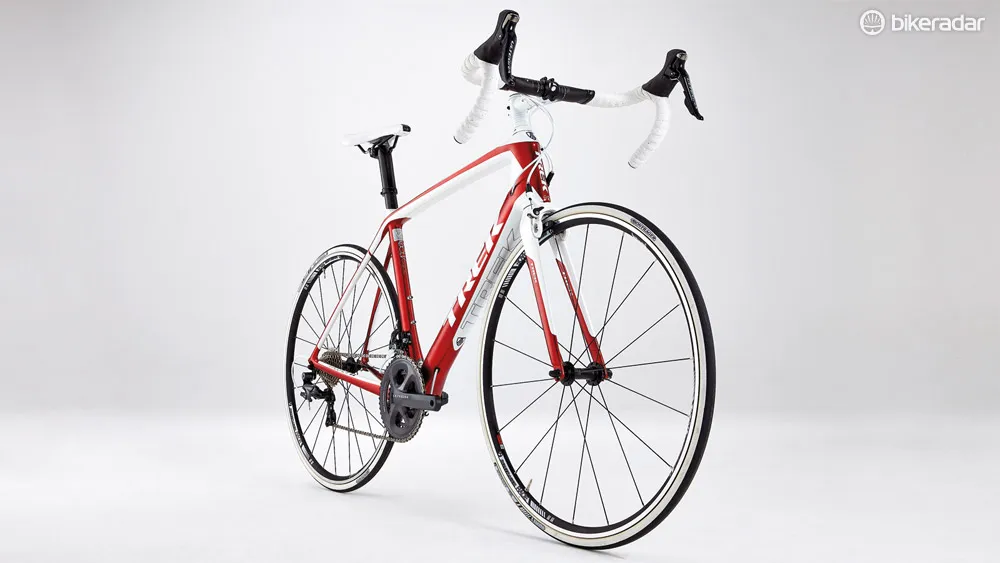
With its bold, contrasting hues and white wall tyres, the Madone 5.2’s aesthetics are like a throwback to the 1950s, but the dynamics are most definitely 2014. The third-tier Madone shares the design and features of the top flight 7-Series but with lower-spec carbon and less expensive parts.
- Highs: Incredible frame rigidity, stability and comfort
- Lows: The top tube is quite wide for muscly legs, and the colour combination won’t appeal to everyone
- Buy if: You want cutting edge frame technology with upgrade potential
At first glance, the 5.2 doesn’t look like a typical aero bike, with its enormous, angular down tube, but closer inspection reveals the subtly curved leading edge that forms a Kamm Virtual Foil (KVF) – a truncated aerofoil – profile. The head tube, seatstays and fork are also KVF shapes, with the front brake integrated into the fork crown and rear brake placed beneath the chainstays, leaving two independent, bridgeless seatstays for clean, drag-reducing lines.
Trek offers its bikes in three different geometries: H1 with the lowest position, H2 featuring a slightly higher head tube and H3 for women. The Madone 5.2’s H2 fit offers a long but not too low position, and should be ideal for the majority of riders looking to race. On the road our first impression is of the sort of stability found on a relaxed-geometry tourer – it just feels planted.
And then we stood on the pedals. In line with several top race bikes, the Madone has the sort of rigidity usually reserved for buildings or oil tankers, its immense BB90 bottom bracket shell ably braced by that vast down tube and muscular asymmetric chainstays, which instantly translate the merest pressure into forward motion.
The Madone 5.2's handling is predictably superb; it also offers a surprisingly comfortable ride
Despite the frame’s rigidity, the ride is firm but never jarring, giving surprising levels of comfort. Handling is excellent, seemingly creating extra time through the corners to amend your line, resulting in no unwanted drama. We did find the front half of the top tube a bit too wide, as your quads can rub against its edges when riding hard on the nose of the saddle or standing up climbing.
Bontrager’s tubeless-ready Race wheelset features 23mm-high, 24mm-wide rims, which definitely play a part in the bike’s stability, cornering ability and overall grip and comfort. They’re not especially light, but are quite accelerative and efficient, and are willing to hold speed well over distance. The Ultegra drivetrain performs faultlessly and the Bontrager integrated brakes do a decent job, though they don’t have the instant bite of Shimano’s direct-mount offerings.
The Bontrager bar is stiff and quite ergonomic, and the Affinity 3 saddle well padded and offering superb comfort. The complete package could benefit from an upgrade diet, but it’s competent and quick straight out of the box.
Share this article
Britain's Best Selling Road Cycling Magazine

- Terms & Conditions
- Subscribe to our magazines
- Manage preferences
- off.road.cc
- Dealclincher
- Fantasy Cycling
Support road.cc
Like this site? Help us to make it better.
- Sportive and endurance bikes
- Gravel and adventure bikes
- Urban and hybrid bikes
- Touring bikes
- Cyclocross bikes
- Electric bikes
- Folding bikes
- Fixed & singlespeed bikes
- Children's bikes
- Time trial bikes
- Accessories - misc
- Computer mounts
- Bike bags & cases
- Bottle cages
- Child seats
- Lights - front
- Lights - rear
- Lights - sets
- Pumps & CO2 inflators
- Puncture kits
- Reflectives
- Smart watches
- Stands and racks
- Arm & leg warmers
- Base layers
- Gloves - full finger
- Gloves - mitts
- Jerseys - casual
- Jerseys - long sleeve
- Jerseys - short sleeve
- Shorts & 3/4s
- Tights & longs
- Bar tape & grips
- Bottom brackets
- Brake & gear cables
- Brake & STI levers
- Brake pads & spares
- Cassettes & freewheels
- Chainsets & chainrings
- Derailleurs - front
- Derailleurs - rear
- Gear levers & shifters
- Handlebars & extensions
- Inner tubes
- Quick releases & skewers
- Energy & recovery bars
- Energy & recovery drinks
- Energy & recovery gels
- Heart rate monitors
- Hydration products
- Hydration systems
- Indoor trainers
- Power measurement
- Skincare & embrocation
- Training - misc
- Cleaning products
- Lubrication
- Tools - multitools
- Tools - Portable
- Tools - workshop
- Books, Maps & DVDs
- Camping and outdoor equipment
- Gifts & misc

Currently, all of the Madones are high-end, the most affordable (it’s all relative!) model being the £4,500 Madone 9.2 (above) with Bontrager Paradigm Elite tubeless ready wheels and a Shimano Ultegra groupset.
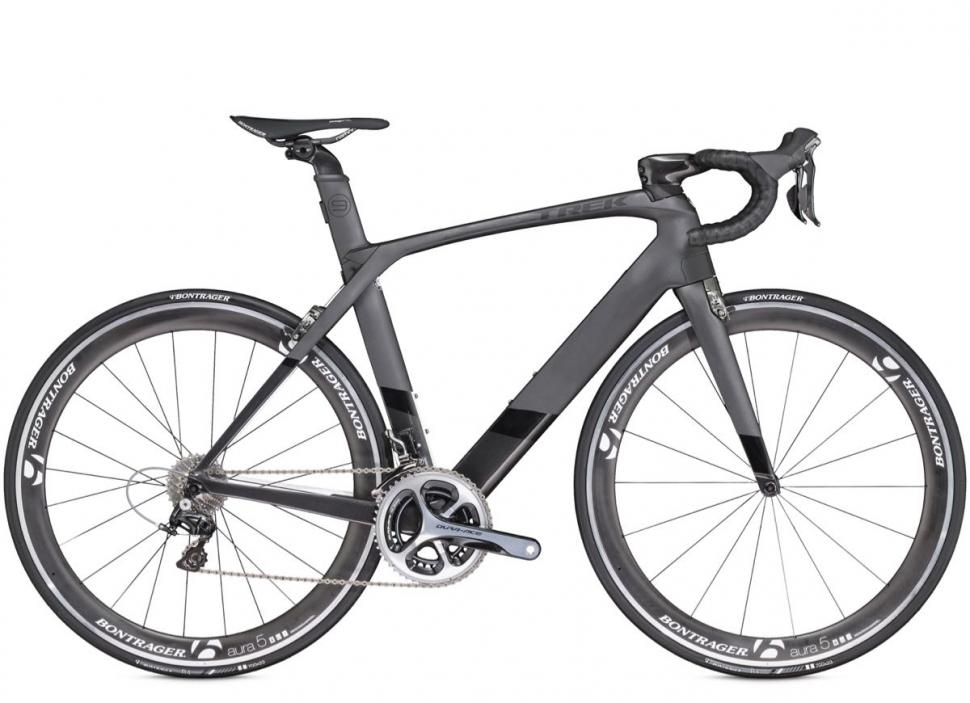
The 9.5 is £6,000. The extra money gets you Shimano’s flagship Dura-Ace groupset and Bontrager’s Aura wheels.
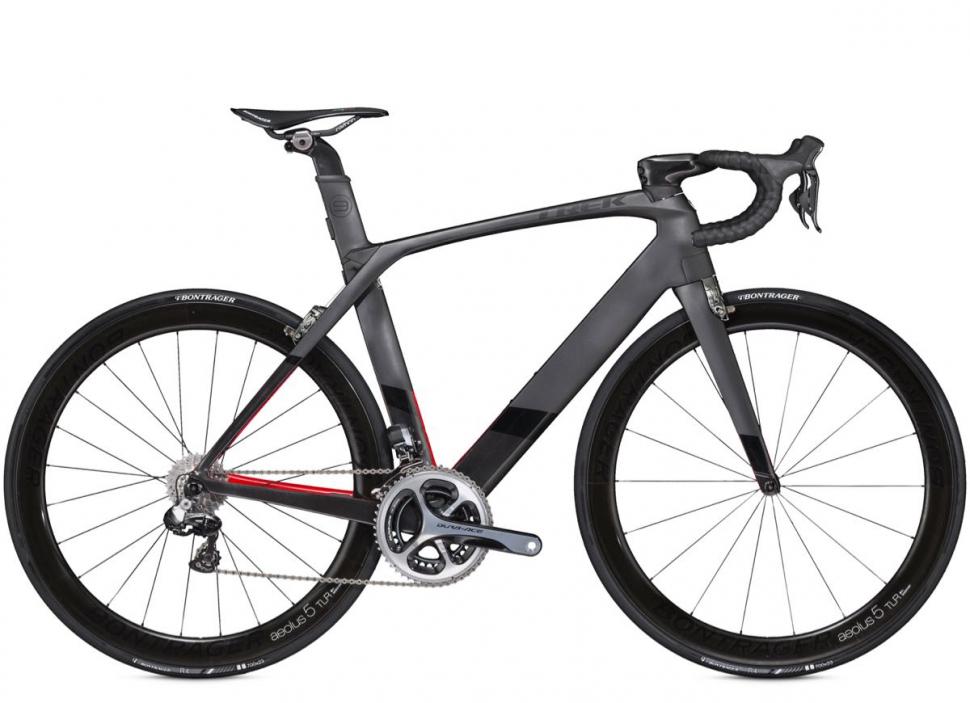
Go to £9,000 and you can have the Madone 9.9 (above) with Bontrager’s very fast Aeolus 5 D3 wheels and the electronic Di2 version of Shimano’s Dura-Ace groupset.

The super-high-end Madone Race Shop Limited (above) tops the range. It comes with the same components as the Madone 9.9 but the Race Shop Limited is built around a 700 Series frame rather than 600 Series – the same version used by the Trek Factory Racing professional riders.
If none of those builds or finishes is exactly what you want, you can use Trek’s Project One system and have a Madone in your dream build. Prices start at £5,450, depending on your spec. We had one made for review and it was a fabulous ride, but it costs!
Trek boasts that the Emonda has been “the lightest production road line ever” since its introduction in mid-2014.
The Emonda range covers three different carbon-fibre frames – the S, the SL and the SLR – and an aluminium model (see below). Each of those frames comes in various different builds, and some come in women’s specific versions.
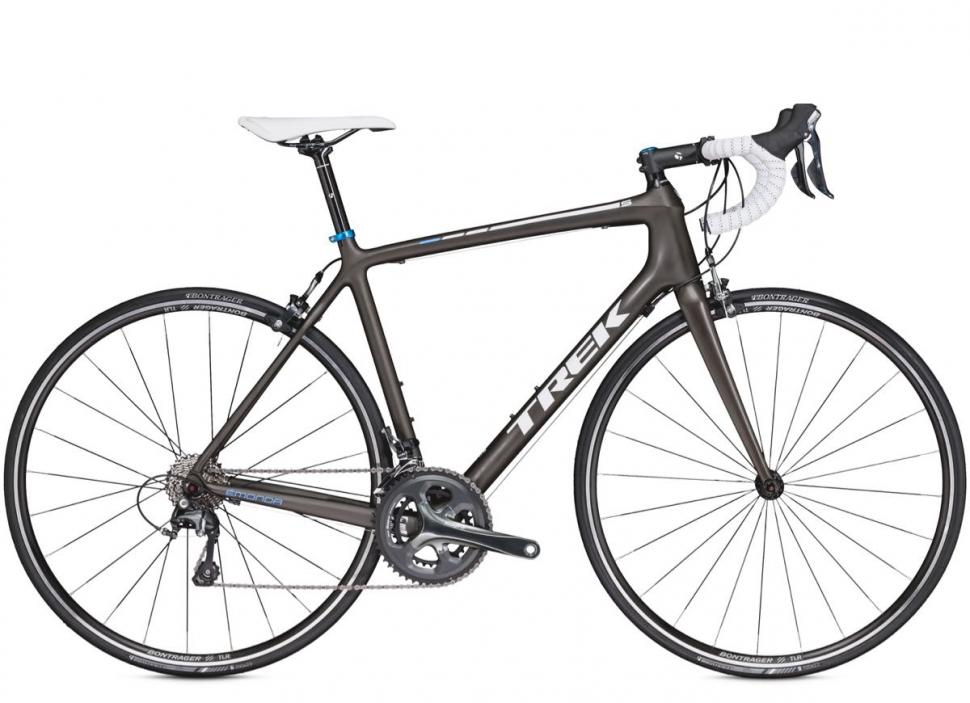
The most affordable carbon-fibre Emonda is the S 4 (£1,100, above), made from Trek’s 300 Series OCLV carbon. It gets a tapered head tube and an oversized bottom bracket for stiffness and is compatible with Trek’s DuoTrap computer sensor that integrates into one of the chainstays. It’s built up with a Shimano Tiagra groupset.
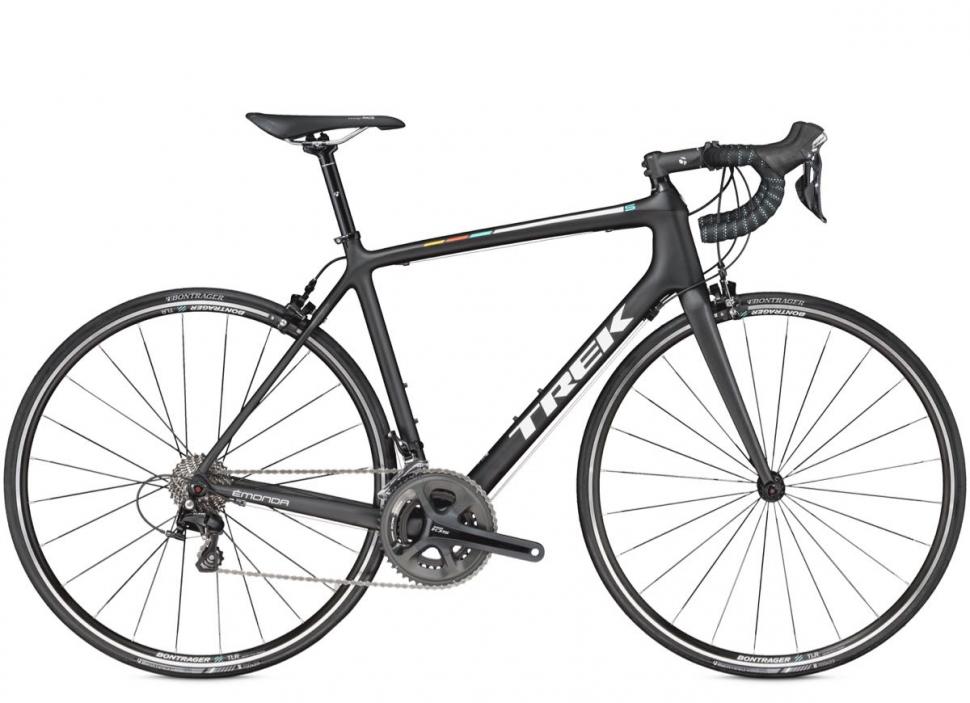
The S 5 (£1,300, above) looks a really attractive options. It’s built around the same frame and fork but its groupset is the next level up in Shimano’s hierarchy, 105 – and we’re big fans of Shimano 105 here at road.cc .
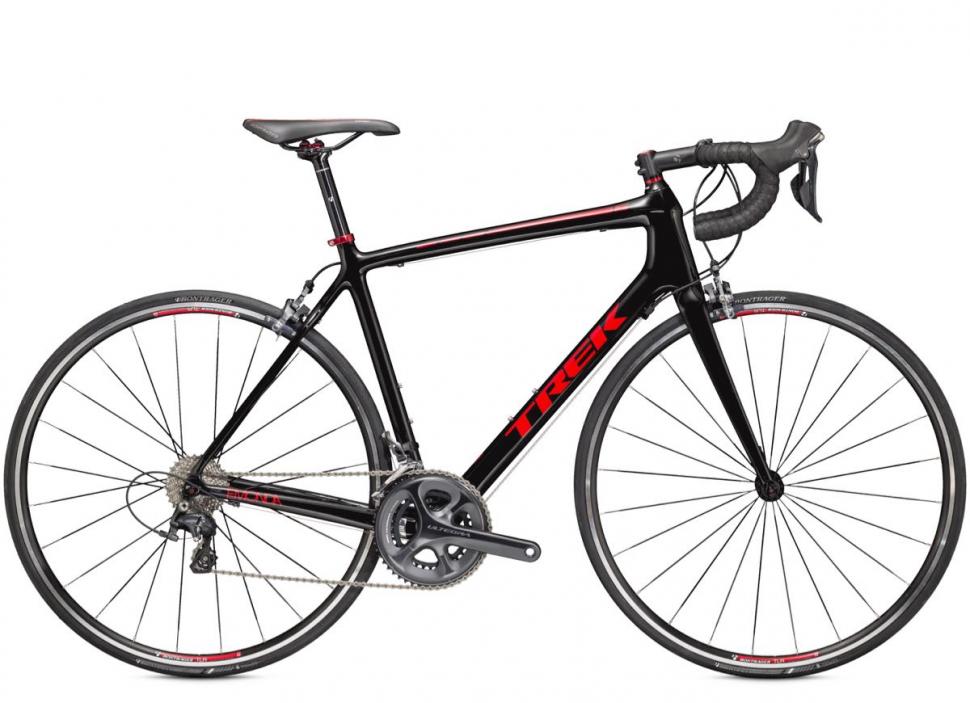
The £1,600 S 6 (above) gets a higher level again: Shimano Ultegra.
The Emonda SLs are made from a higher level of carbon fibre – Trek’s OCLV 500 Series – have wide BB90 bottom brackets and full-carbon forks. They also have seatmasts rather than standard seatposts to save weight and improve comfort.

The most accessible of the Emonda SLs is the 5, available in both men’s and women’s models (above), equipped with a Shimano 105 groupset and Bontrager Race tubeless ready wheels.
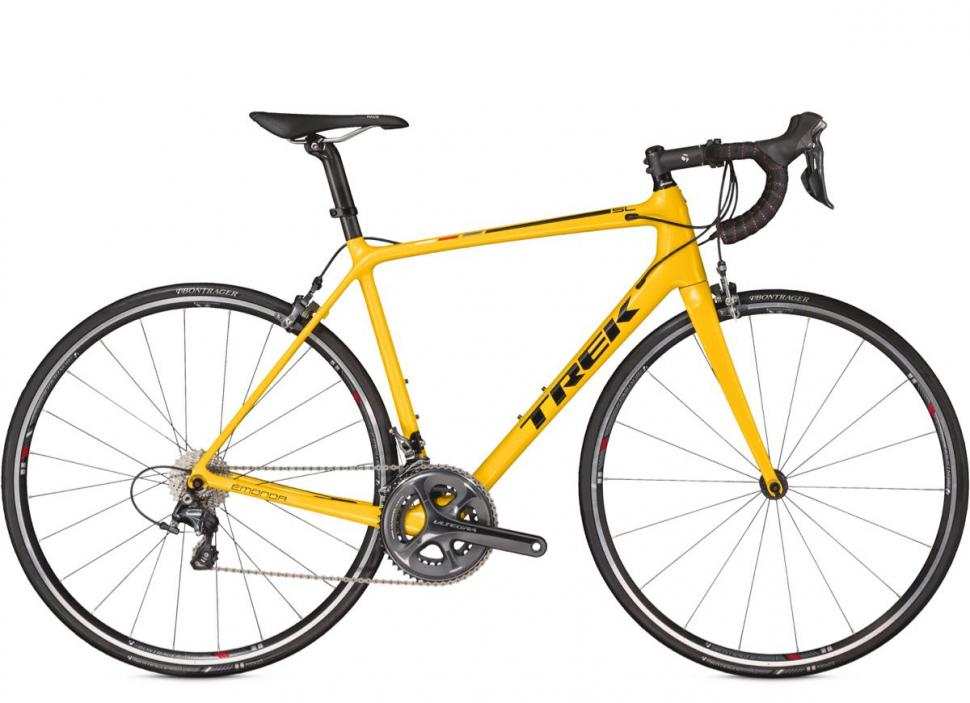
We very much like the look of the £2,100 Emonda SL 6 which comes in a Shimano Ultegra build while the top-level SL 8 (£2,900) is available in either Dura-Ace or Red – each the top level offerings from Shimano and SRAM respectively.
The SLR Emondas are the lightest of the bunch. Trek claims that the 700 Series OCLV carbon-fibre frame weighs just 690g. That’s astonishingly light.
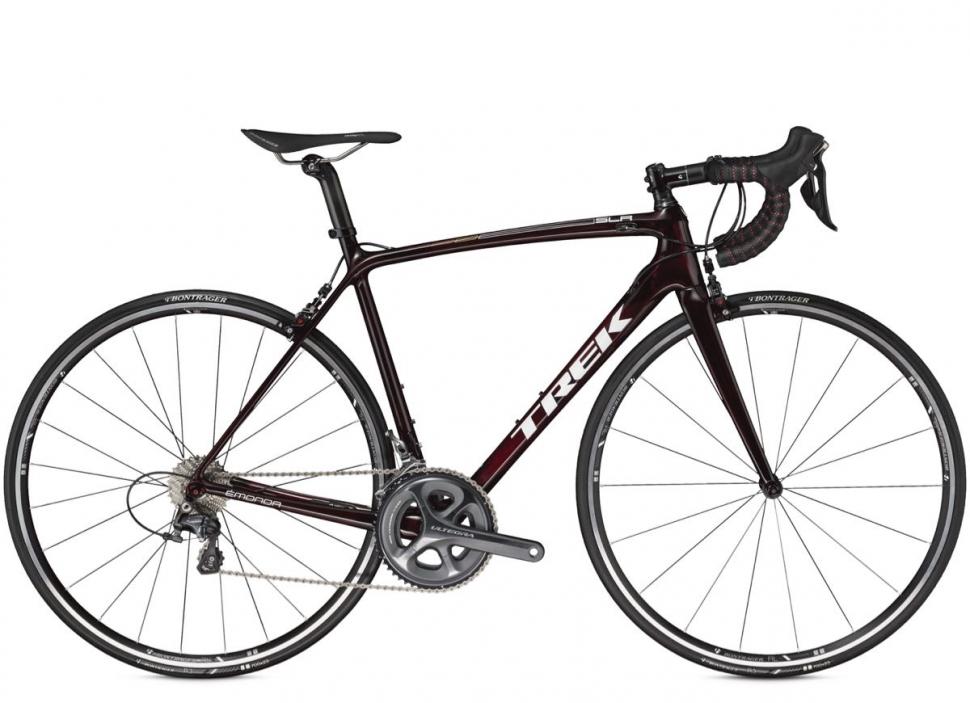
The Shimano Ultegra-equipped SLR 6 (£4,300, above) is available in either an H1 or and H2 fit (see above), so you can pick the setup that works best for you.

The same is true of the SLR 8 (above, £5,800) which comes with Shimano Dura-Ace components.
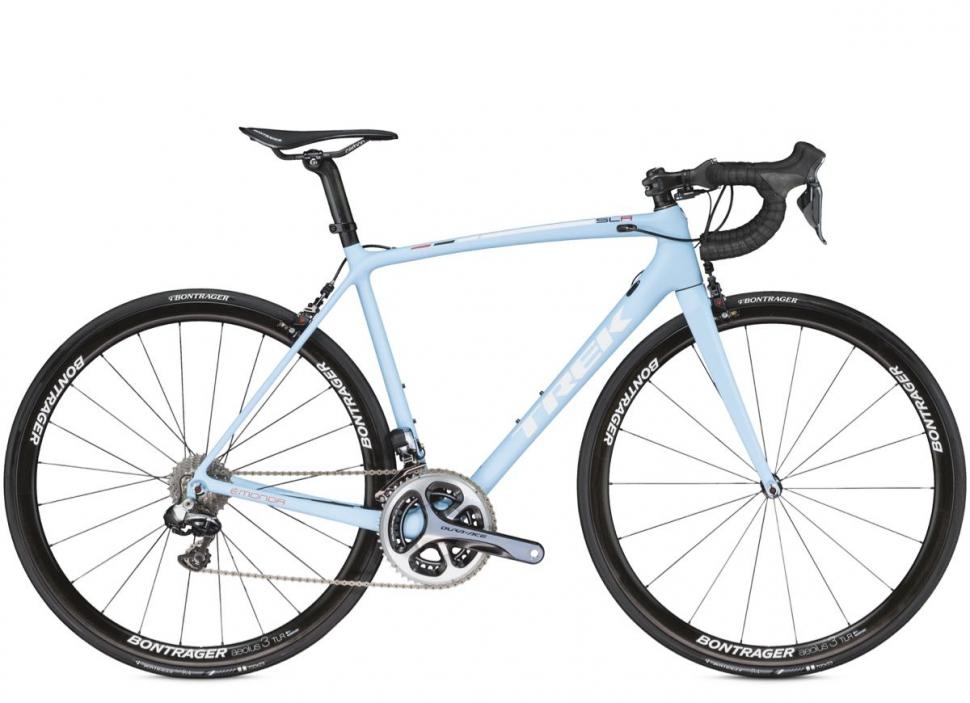
If you want electronic shifting, the £8,000 SLR 9 (above) is a real stunner with Dura-Ace Di2 and Aeolus 3 D3 TLR wheels from Trek’s in-house Bontrager brand.
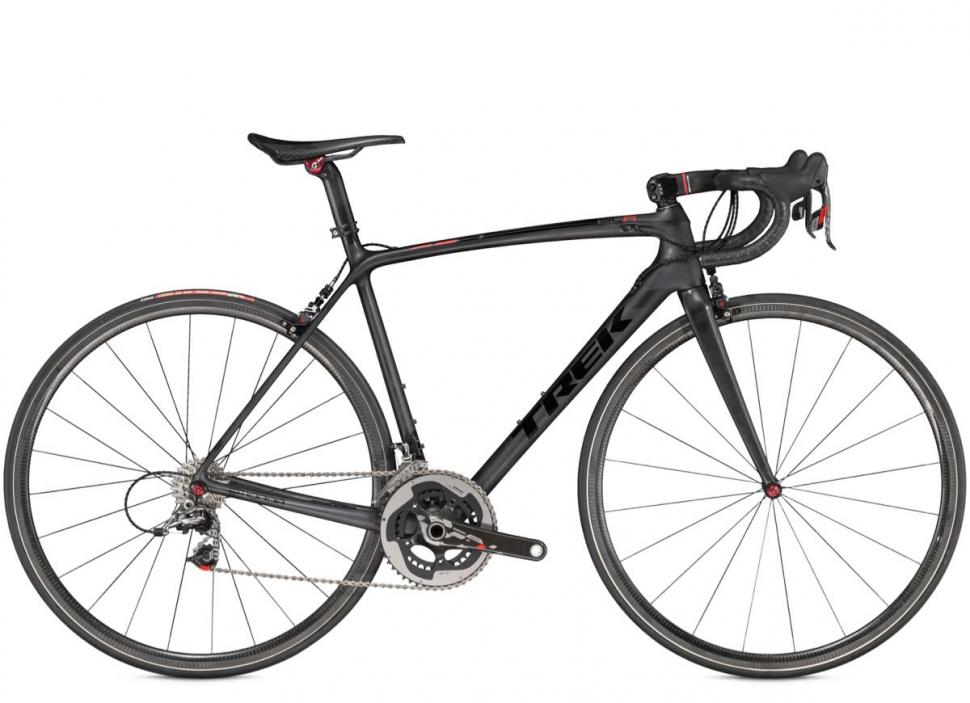
Trek claims that the top level Emonda SLR 10 (above) weighs an incredible 10.25lb (4.6kg) in a 56cm frame and H1 fit. The boutique build includes superlight wheels and a carbon saddle from Tune and an integrated bar and stem from Bontrager. How much? Um, sadly it’s £11,000!
A year after the introduction of the carbon-fibre Emondas, Trek introduced an aluminium version. It’s not quite as lightweight as the carbon ones but it’s still pretty darn light and fast, and the ride quality is very good.
The alu Emonda features a tapered head tube for accurate cornering and it comes in Trek’s H2 fit – performance-orientated but not extreme. The welds are almost invisible to the point that you’d be hard pressed to see that this is an aluminium bike at first glance.

The Emonda ALR 4 (above, £900) is fitted with a Shimano Tiagra 10-speed groupset but we think that the £1,100 ALR 5 (below) is the pick of the bunch.
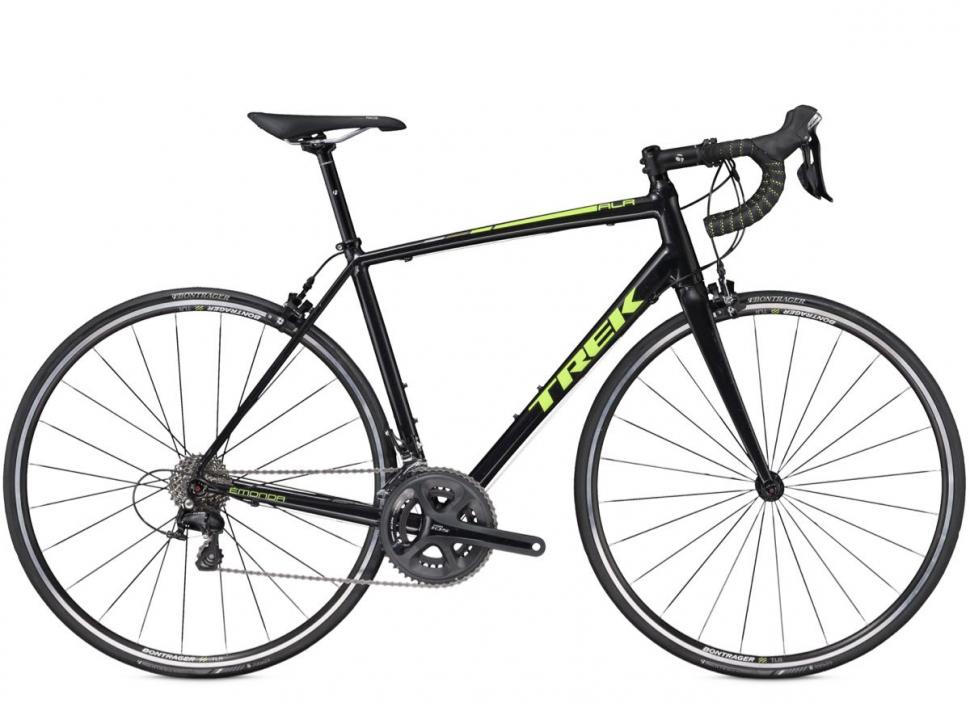
It has a full Shimano 105 groupset, a full carbon fork and a very good Bontrager Paradigm Race saddle.
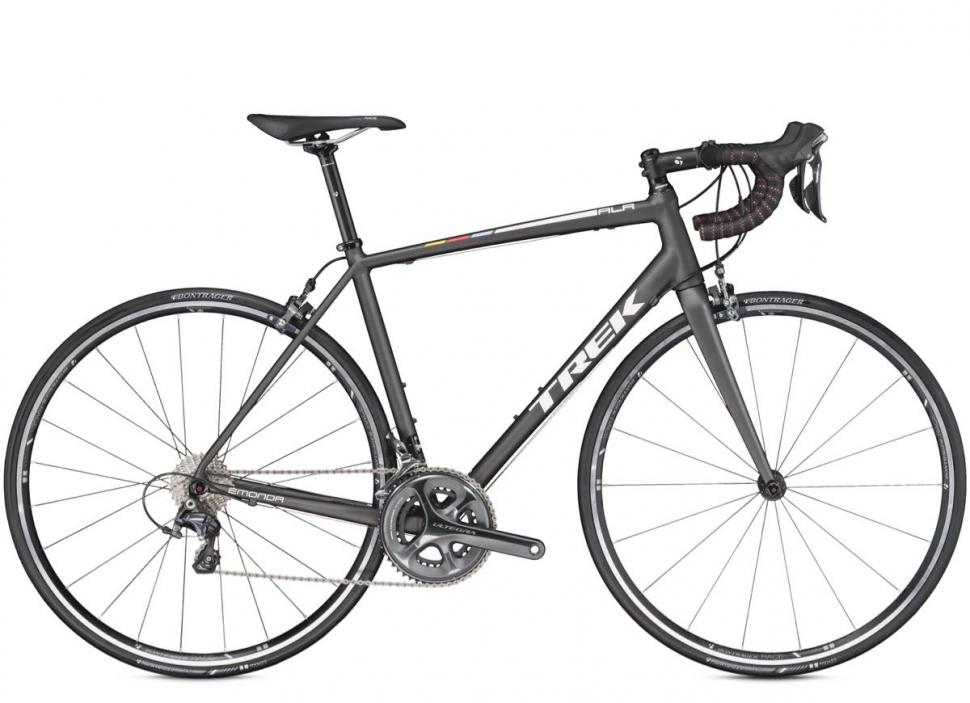
The ALR 6 (above), which we have reviewed here on road.cc , comes equipped with Shimano Ultegra and it’s another aggressively priced model at £1,400.
Like most bikes at this price point, all of the Emonda ALR models come with compact gearing (smaller than standard chainrings) to help you get up the hills.
The Domane is Trek’s endurance race bike that sits alongside the Madone and the Emonda (above). This is the bike you’ll see most of Trek’s professional riders aboard on the cobbled classics like Paris-Roubaix because of the way it copes with lumps and bumps.
The frame features an IsoSpeed decoupler (see above) that allows the seat tube to move independently of the top tube and the seatstays. It can pivot back and forth to soak up vibrations and cancel out bigger hits from the road surface.
The Domanes also come with IsoSpeed forks that are designed to add more comfort to the ride, and they’re built to an endurance geometry, meaning that the position is a little more upright than normal to put less strain on your back.

The Domane range opens with the £900 2.0 (above) that centres on a 200 Series Alpha Aluminium frame and a carbon fork. The 10-speed Shimano Tiagra groupset includes a compact chainset and an 11-32-tooth cassette, giving you some small gears for climbing long, steep hills.
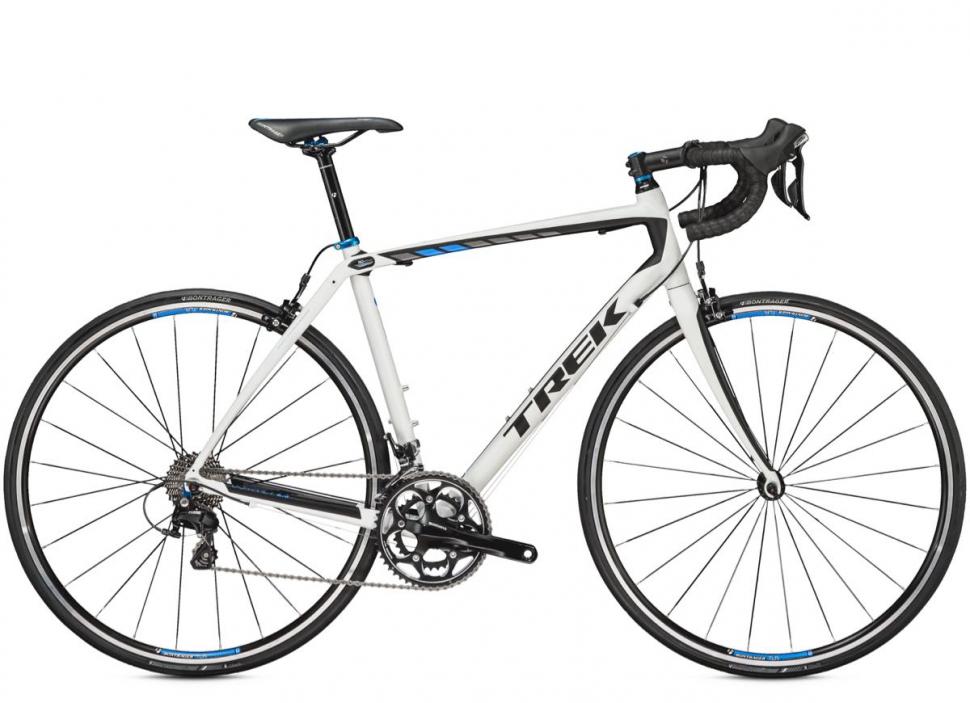
Pay £1,100 for the Domane 2.3 (above) and you can upgrade to a Shimano 105 groupset.
All the other Domanes are carbon-fibre. The 4 Series bikes get oversized BB90 bottom brackets and tapered head tubes for stiffness, along with almost invisible mudguard mounts. As well as standard rim brake models, this series includes disc brake bikes for more stopping control in all weather conditions.
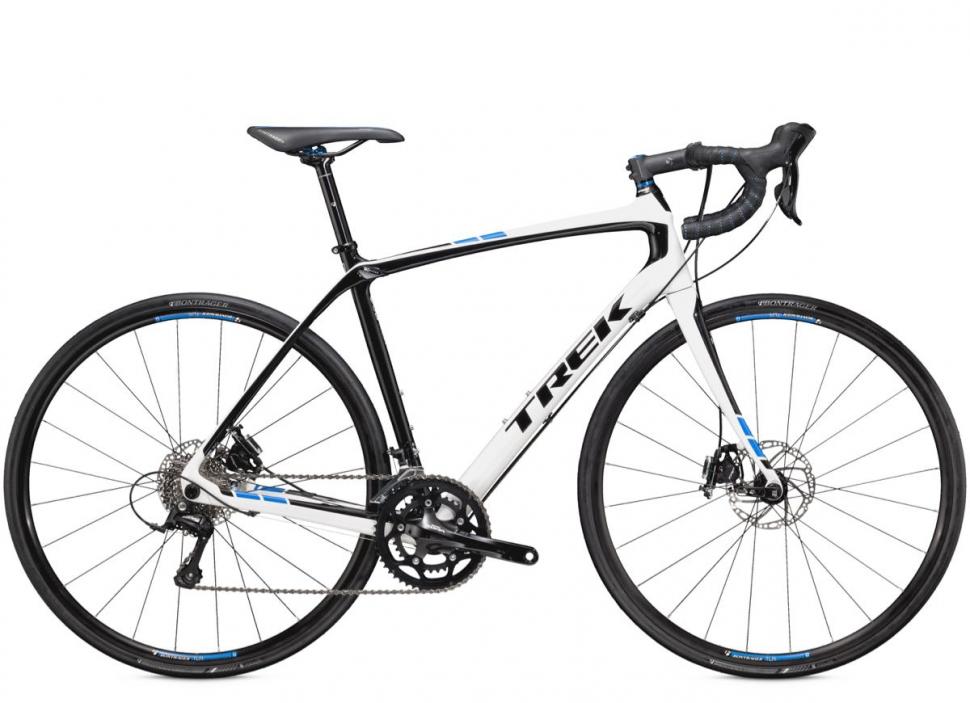
The cheapest of these is the £1,400 Trek Domane 4.0 Disc (above) which is built with a 9-speed Shimano Sora groupset and TRP’s HY/RD cable-operated hydraulic disc brakes.
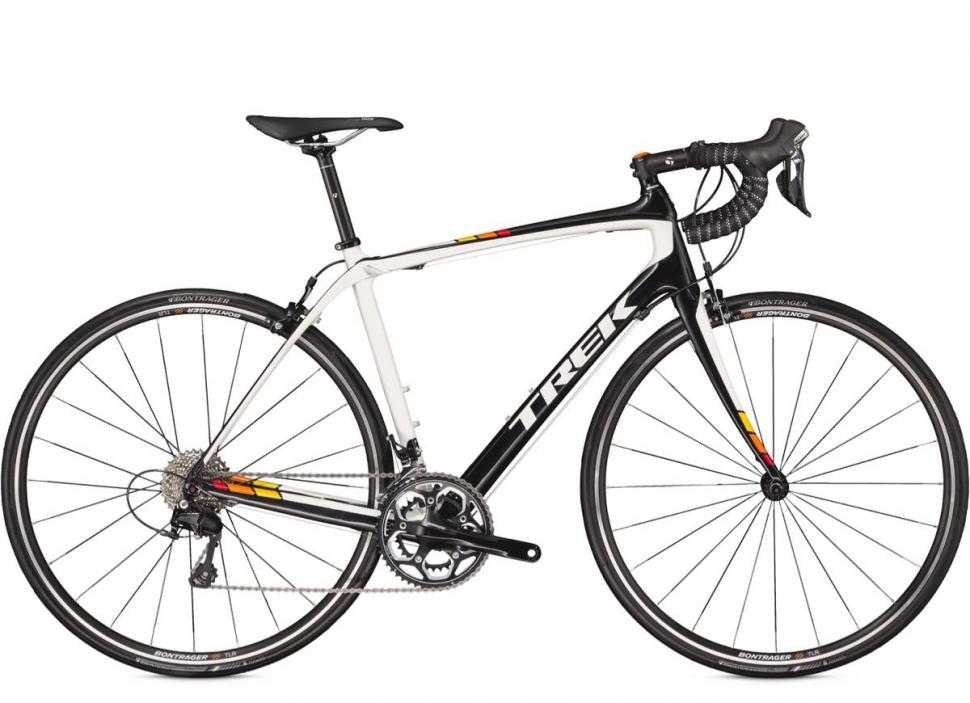
The 4.3 (above) looks like a winner to us. With a reliable Shimano 105 groupset, it’s priced at £1,500.
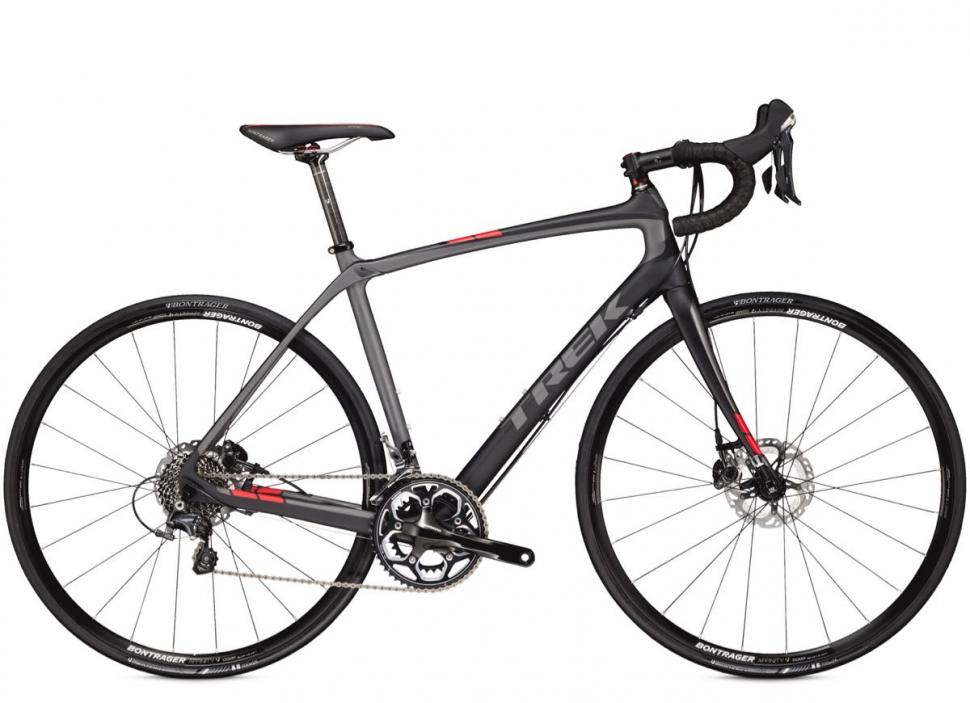
The 4.5 is available in both rim brake and disc brake versions (above). The bikes’ Shimano Ultegra components are the same whichever model you choose but the 4.5 Disc (£2,200) has Shimano RS685 hydraulic disc brakes that operate on 160mm rotors rather than the Shimano 105 rim brakes of the standard Domane 4.5 (£1,800).
The 5 Series Domanes are made from a higher grade of carbon-fibre and feature seatmasts rather than seatposts, the idea being to add comfort and save a little weight.
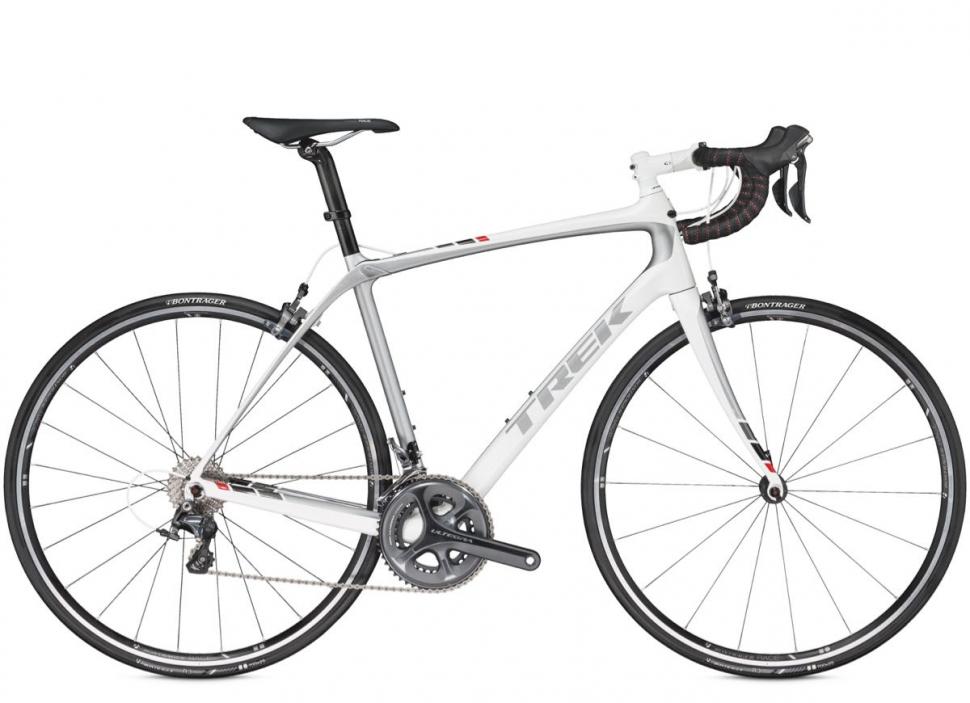
The £2,200 Domane 5.2 (above) is a Shimano Ultegra model that looks like good value for money while you can have the £3,000 5.9 in either top-level Shimano Dura-Ace or with electronic shifting courtesy of Shimano’s second tier Ultegra Di2. The choice is yours.
Go up to the Domane 6 Series and you shift from 500 Series OCLV carbon to 600 Series which is a little lighter and stiffer.

The 6.2 is available in rim brake and disc brake (above) versions – £2,900 and £3,200 respectively – the disc brakes in question being Shimano RS685 hydraulics. These are Ultegra-level, matching most of the rest of the spec.
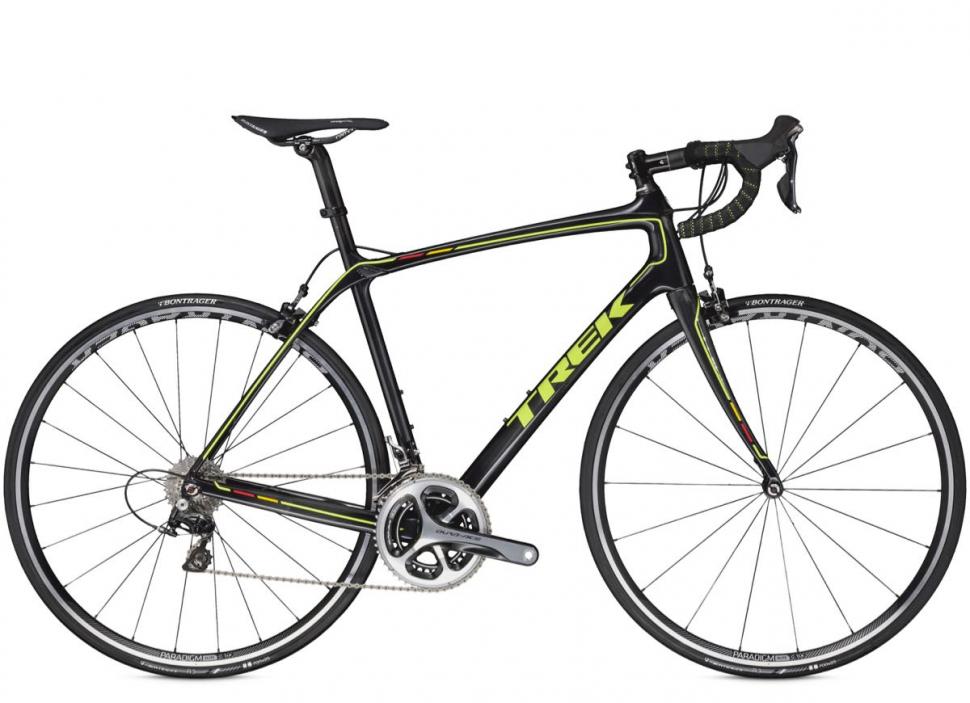
The £3,900 Domane 6.5 (above) has a full Shimano Dura-Ace group along with a lightweight Bontrager Paradigm Elite TLR wheelset, while the 6.9 Disc (below, £6000) gets Shimano’s Dura-Ace Di2 electronic shifting, RS785 hydraulic brakes, and Bontrager Affinity Elite wheels.
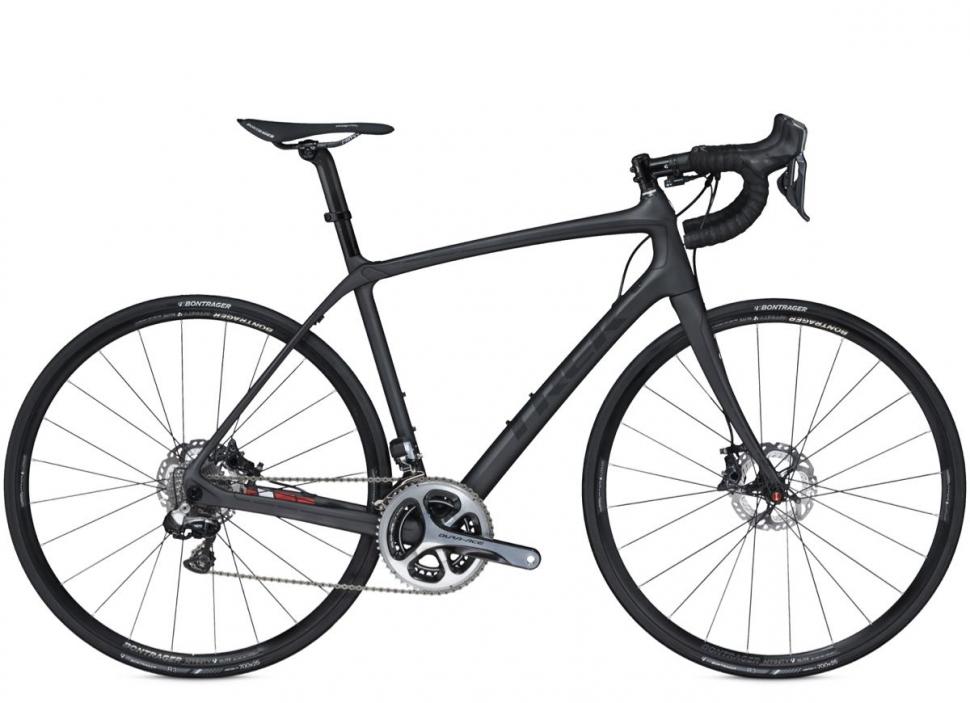
The rim brake version of the 6.9 (below, £7,200) gets that same Di2 shifting, the higher price being down to Bontrager’s aero Aeolus 3 D3 wheels that we’re reviewed here on road.cc . They’re fast and they handle well whatever the conditions.

You can choose your own spec and finish for both the Domane 4 Series and 6 Series through Trek’s Project One scheme.
The 1 Series contains Trek’s entry-level road bikes. They’re made from Trek’s 100 Series aluminium (the Emonda ALRs are 300 Series) and they have eyelets for fitting mudguards and a rear rack. That’ll come in handy if you intend to commute by bike year-round.
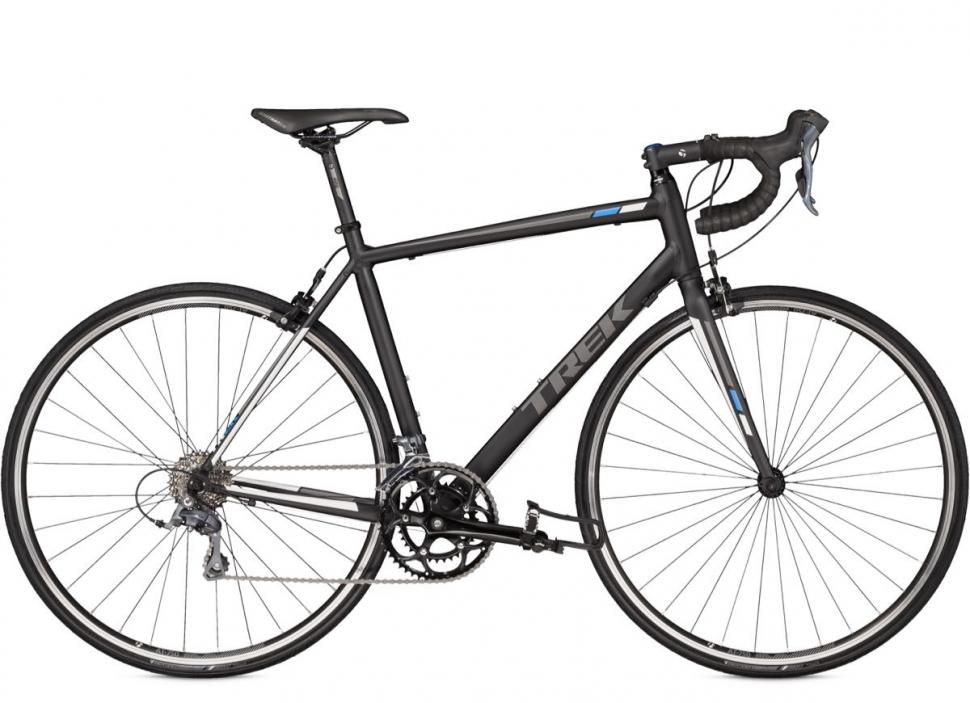
Like the Emonda ALRs and many other Emonda and Madone models, the 1 Series bikes are built to Trek’s H2 geometry. This is a setup that’s designed for efficiency and speed, but it’s not quite as low and stretched as Trek’s H1 fit.
There are just two models in the range. The £575 1.1 (above) gets an 8-speed Shimano Claris groupset while the £650 1.2 (below) is built up with 9-speed Shimano Sora.
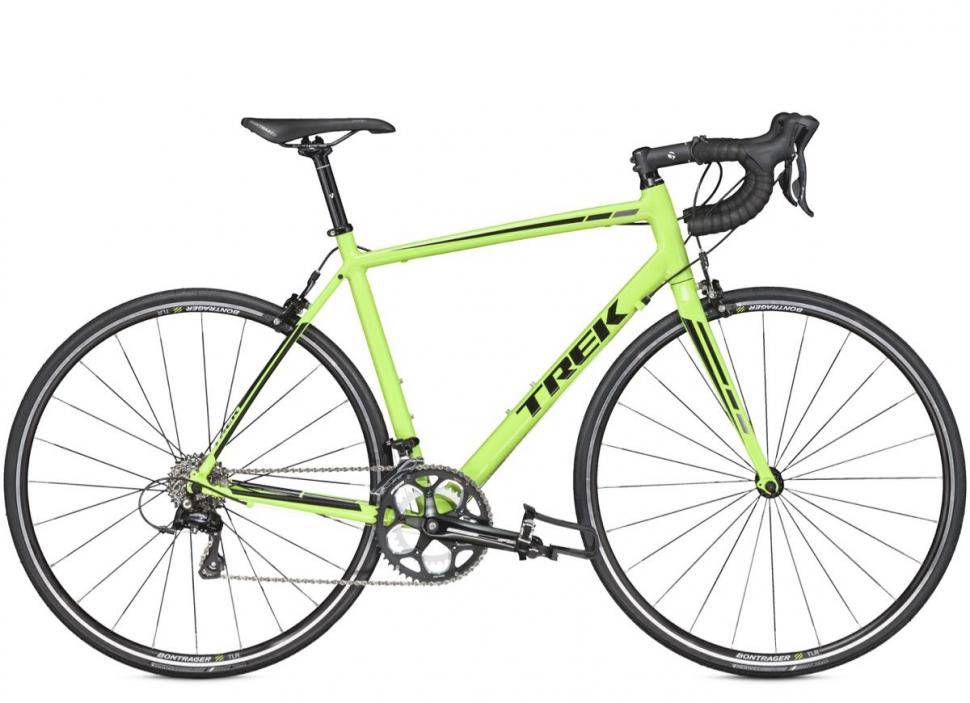
The Silque is a women’s carbon-fibre bike that, like the Domane and now the Madone, has an IsoSpeed decoupler to add comfort and control.
Trek doesn’t just change the colour and a few components when putting a women’s bike together, the frame geometry is altered too.
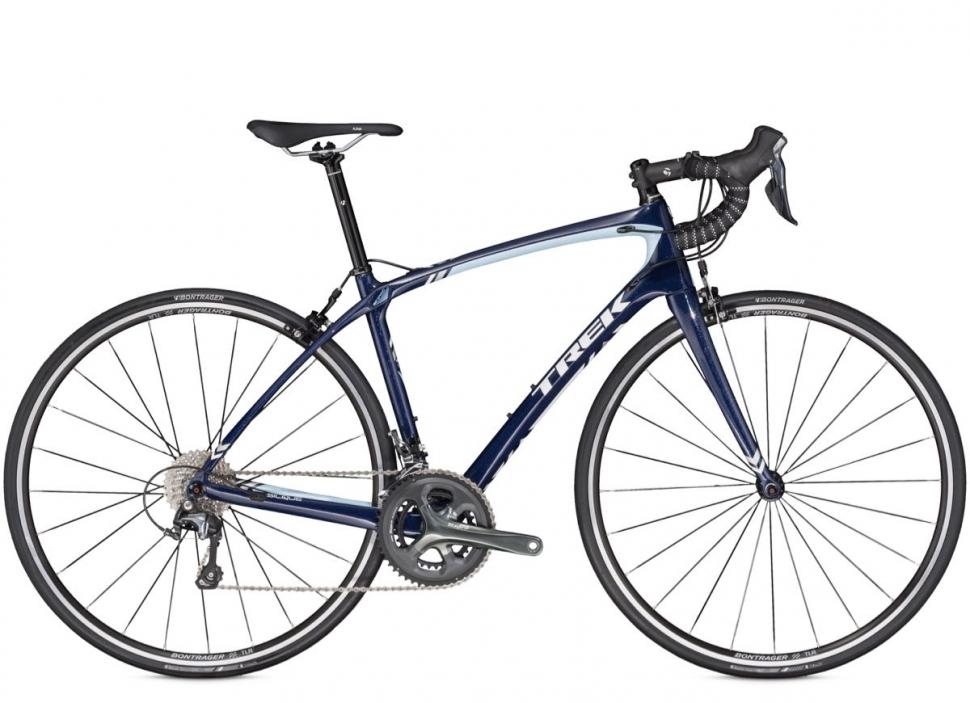
There are six different Silque bikes in the lineup ranging from the £1,500 Shimano Tiagra-equipped Silque (above) right up to the £3,800 Silque SSL (below) with Shimano Ultegra Di2 electronic shifting.
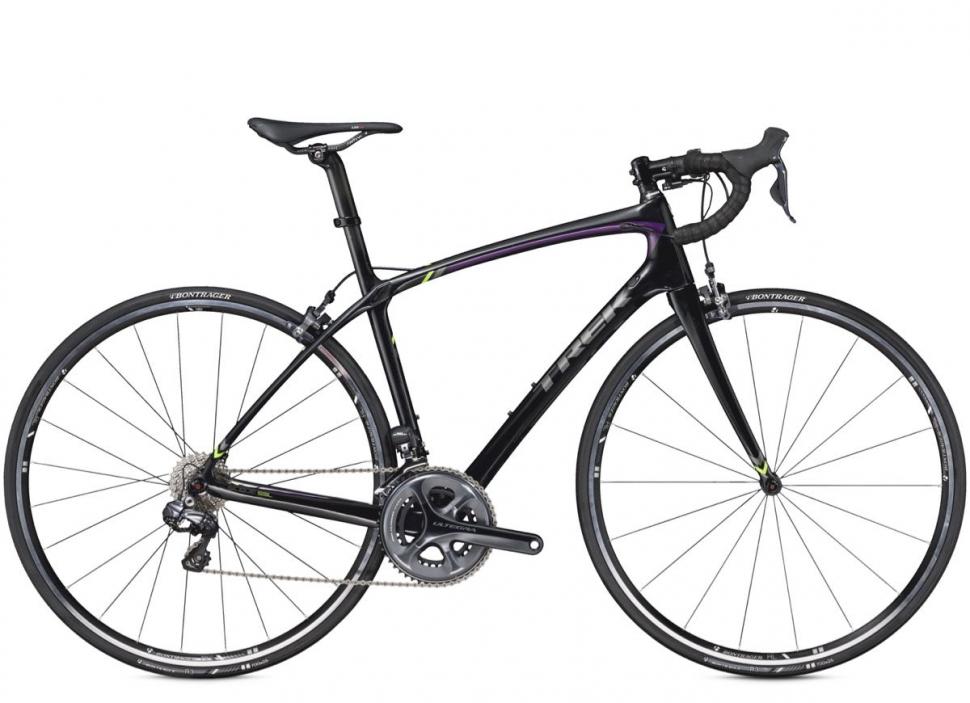
We think that the Silque SL (£2,200, below) looks like a great bike that’ll prove popular. With a full Shimano Ultegra drivetrain, Bontrager Race tubeless ready wheelset, and women’s specific Bontrager Anja Comp WSD saddle, you’re getting a lot for your money here.
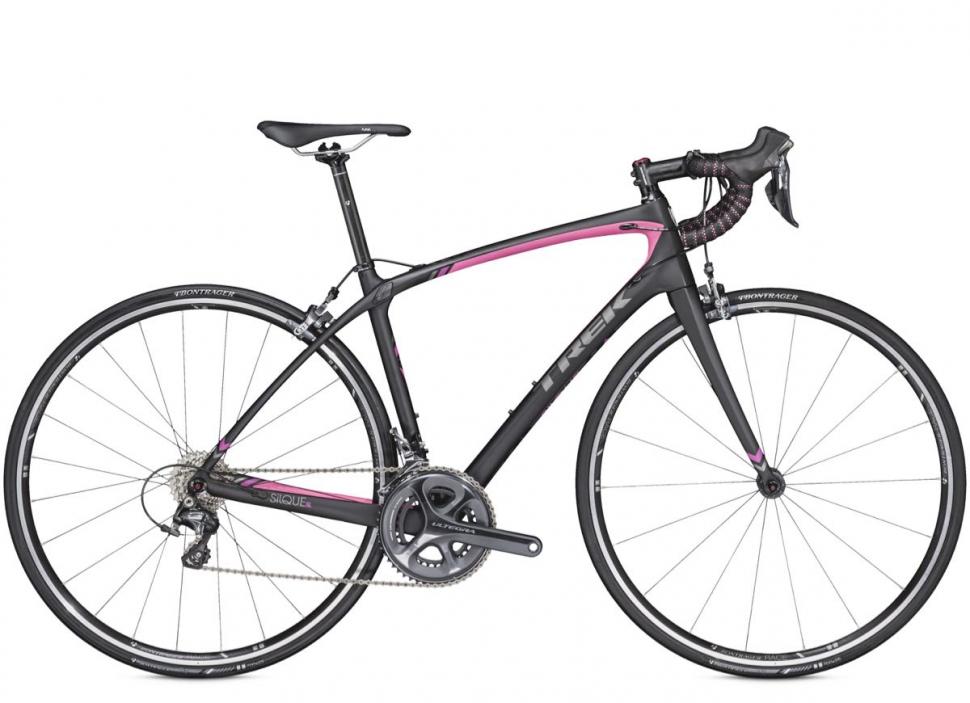
The Silque SL and SSL are available through Trek’s Project One service from £2,700 and £3,970 respectively.
The Lexa is Trek’s aluminium road bike range that’s built to a WSD (women’s specific design) geometry.

Three of the four bikes in the range are based around frames made from 100 Series Alpha Aluminium, the same as the 1 Series bikes (above), while the fourth, the £1,000 Lexa SLX (above), uses slightly higher level 200 Series. All the bikes are mudguard and rack compatible.

The cheapest bike in the range is the straight Lexa (above) at £575 but the one that takes our eye is the £650 Lexa S (below). This one has a 9-speed Shimano Sora groupset and tubeless ready tyres from Bontrager.

For more info go to www.trekbikes.com .
Help us to fund our site
We’ve noticed you’re using an ad blocker. If you like road.cc, but you don’t like ads, please consider subscribing to the site to support us directly. As a subscriber you can read road.cc ad-free, from as little as £1.99.
If you don’t want to subscribe, please turn your ad blocker off. The revenue from adverts helps to fund our site.
Help us to bring you the best cycling content
If you’ve enjoyed this article, then please consider subscribing to road.cc from as little as £1.99. Our mission is to bring you all the news that’s relevant to you as a cyclist, independent reviews, impartial buying advice and more. Your subscription will help us to do more.
Mat has been in cycling media since 1996, on titles including BikeRadar, Total Bike, Total Mountain Bike, What Mountain Bike and Mountain Biking UK, and he has been editor of 220 Triathlon and Cycling Plus. Mat has been road.cc technical editor for over a decade, testing bikes, fettling the latest kit, and trying out the most up-to-the-minute clothing. He has won his category in Ironman UK 70.3 and finished on the podium in both marathons he has run. Mat is a Cambridge graduate who did a post-grad in magazine journalism, and he is a winner of the Cycling Media Award for Specialist Online Writer. Now over 50, he's riding road and gravel bikes most days for fun and fitness rather than training for competitions.
Add new comment

Isn't there a Domane 4.3 with disc brakes as well? Hope so, I was going to buy one.
- Log in or register to post comments
you can get a 2016 Giant Defy 1 disc for £999 with TRP Spyre mech discs and 105 groupset, aluminium alloy frame and carbon fibre leg/ alloy steerer fork. Not a bad deal...
So entry level for Trek with *Sora* & HyRd discs is £1,400 - TBH they could have gone for Spyres and added Tiagra under-bar shifting.
Disappointing that one of the world's largest can't bring a disc bike in closer to a grand - When Merida have the amazing Ride 5000 Disc 2016 with 105/Ultegra & full Hydro for only £550 more. Yes, I say 'only' as the RRP jumps for Sora-> 105/Ultegra & HyRd-RS785 must be close to a grand RRP.
KiwiMike wrote: So entry level for Trek with *Sora* & HyRd discs is £1,400 - TBH they could have gone for Spyres and added Tiagra under-bar shifting. Disappointing that one of the world's largest can't bring a disc bike in closer to a grand - When Merida have the amazing Ride 5000 Disc 2016 with 105/Ultegra & full Hydro for only £550 more. Yes, I say 'only' as the RRP jumps for Sora-> 105/Ultegra & HyRd-RS785 must be close to a grand RRP.
Merida are a pretty monstrously large operation - their wholesale buying power from Shimano, etc. must be almost unparalleled. I'm not that surpried they can offer these specs at that price. Around where I live in NZ, there are an awful lot of people on high end Merida bikes with Di2 and so on who wouldn't have spent what an "equivalent" Specialized (made in the same factory) would have cost. Merida's largest failing in many ways appears to be their rather slack approach to marketing.
Latest Comments
Not Campag == not art
On the video here, would it make a difference to have pulled out to primary to go throught the speed cushions at the start of the video - say 4-5s...
I think the mass of the car can be treated as infinite, in the sense that the velocity of the car is not going to change much at all on impact....
Signs installed by Devizes Town Council. AFAIK they are not the Local Highways Authority, and have no authority to install such signs.
Tom Allen? Please tell me you don't mean the comedian.
A flame thrower dog robot is something every cyclist needs.
Riese and Muller Roadster, quality, comfortable bike. Bosch performance line, belt drive and di2 alfine. I've had one puncture, two hub gear oil...
Probably there are some counterexamples (Health and Safety haven't taken over the asylum yet). However it should make people take notice, if only ...
it used to be, obviously opinions differ. But the stuff they sold a decade ago, absolutely was very good quality stuff, it felt quality too,and...
Most Popular News

IMAGES
VIDEO
COMMENTS
All use the same brake calipers and integrated bar. Sizing now mirrors the Emonda. Seven sizes, 50-62cm, are offered in H1; and nine from 47 to 64cm in H2. - Madone 9.2, $6300, built with Shimano ...
We've seen this before on Trek's Domane road bike and it's also available on Trek's top-end hardtail mountain bike, the Procaliber. The 2016 Madone takes the IsoSpeed design in a slightly different direction with an impressive tube-in-tube design. Left: A view of the internals of Trek's new IsoSpeed tube in tube system.
The most accessible Trek Madone 9 Series bike is the 9.2, equipped with a Shimano Ultegra mechanical groupset and Bontrager's new Paradigm Elite wheels. ... but Trek painted it in road.cc colours for our review. ... While Trek has reduced prices on many 2016 bikes, I'm surprised to see such a price hike on the new top Madone compared to the ...
A magic carpet ride — if you can fit within the parameters
The 2016 Trek Madone. The first thing you notice when you see the 2016 Madone is the cable-free front end of the bike. Starting at the top, you'll find the integrated aero bar and stem. This is the result of Trek's goal to leave "no stone unturned, no cable in the wind.". The integrated bar uses Kamm Virtual Foil (KVF) tube shaping ...
Trek's Madone 2.1 is a solid, dependable £1,000 road bike that can turn its hand to everything from commuting to sportives. You'd be hard pressed to point out any particular aspect of this bike that's stunning, but it's remarkably consistent across the board. ... So, our 58cm review bike has a 19cm head tube and an effective top tube of 57.4cm ...
Trek Madone 9 Series first ride review Aero speed without the usual compromises By James Huang/BikeRadar. published 30 June 2015. ... Fork: 2016 Trek Madone KVF Headset: Integrated
Aero road racer with ISO Speed decoupler
Trek Madone 9.2 review. Aug 2016 · Colin Levitch. The new Madone is one of the most comfortable and integrated road bikes on the market, but the fully hidden cables are sure to be a headache in the long run. Buy if you want a race bike that won't leave your body beaten and battered at the end of the day. Highs.
2016 Trek Madone - What we know, what we expect | BikeRadar. An ultra-fast, no-compromise, pure aero machine.
Trek madone available from http://tidd.ly/bfd0dd85Thanks for watchingPlease Like, Share and SubscribeFollow me on Facebook at https://www.facebook.com/ratty....
In fact, the 52cm H2 Madone 6-Series frame we tested more than two years ago weighed 948g, while this new one is 1,000g even despite the more compact H1 front triangle geometry. Likewise, fork ...
The all-new Madone sets a new benchmark for race performance;The IsoSpeed offers the best vertical compliance & aerodynamics; Every detail is designed for ul...
How does Trek's aluminium Madone shape up?
Weight: 7.05 kg. Price: € 12,999. The Geometry of the Trek Madone 9.9. The spec list reads equally as well, and the compact cranks offer enough range to play in the high mountains. It might sound paradoxical for an aero race bike, but it's the truth: in Trek's mind the Madone was designed as the ultimate bike for amateurs with high ...
Trek Madone 9.2 review. Aug 2016 · Colin Levitch. The new Madone is one of the most comfortable and integrated road bikes on the market, but the fully hidden cables are sure to be a headache in the long run. ... Canadian Cycling Magazine takes a look at the custom Trek Madone of Fabian Cancellara, at the 2016 Tour de France. Read Review. Trek ...
The new Trek Madone will have its official WorldTour coming out party underneath members of the Trek Factory Racing team starting July 4 at the 2016 Tour de France. Spec and Pricing. Madone 9-Series Race Shop Limited ($13,650): H1 geometry, 700-Series OCLV Carbon, Shimano Dura-Ace Di2 9070 drivetrain, Bontrager Aeolus 5 D3 TLR wheels. Madone 9. ...
Trek Madone 5.2 Road Bike user reviews : 4.1 out of 5 - 101 reviews. Read it's strength, weaknesses, find deals and pricing - roadbikereview.com ... Trek Madone 5.2 Road Bike ... this bike it was on sale in intersport 50% off 3450€ to 1700€ it had ben sat there for two years. great find oct 2016
Trek is one of the most recognizable bike brands in the world and the Madone has been one of its most successful bikes over the last two decades. With the Madone SLR 6 Disc Speed nothing changes there and it is a pure joy to ride. Its aero-geometry is, unsurprisingly, well thought out and it's a bike that begs to be ridden fast.
Aero speed without the usual compromises
It's a full $1,000 / £1,000 more than the equivalent outgoing Gen 6 Madone SLR 7, and you'd have to look hard to find a more expensive Ultegra Di2-equipped bike from the other mainstream ...
An aero-friendly incarnation of the third-tier Madone
If you want electronic shifting, the £8,000 SLR 9 (above) is a real stunner with Dura-Ace Di2 and Aeolus 3 D3 TLR wheels from Trek's in-house Bontrager brand. Trek claims that the top level Emonda SLR 10 (above) weighs an incredible 10.25lb (4.6kg) in a 56cm frame and H1 fit.